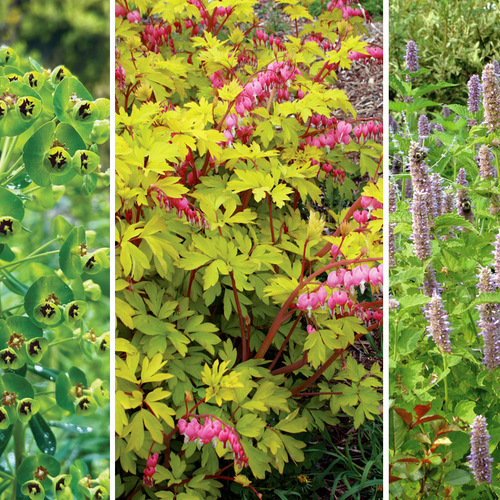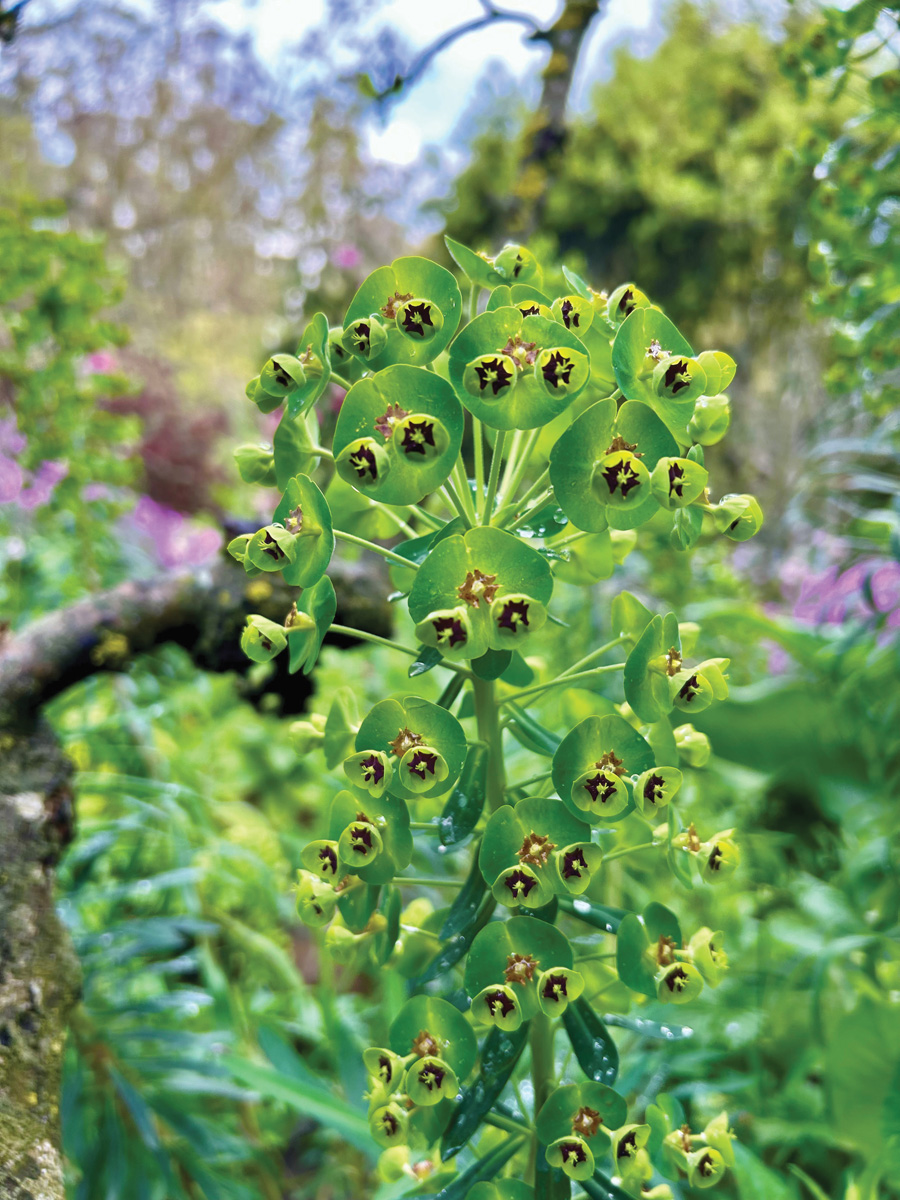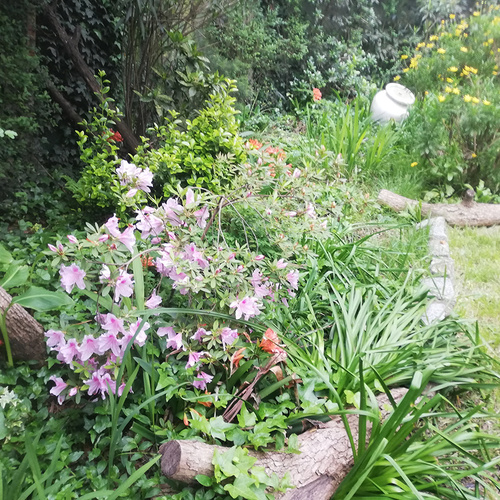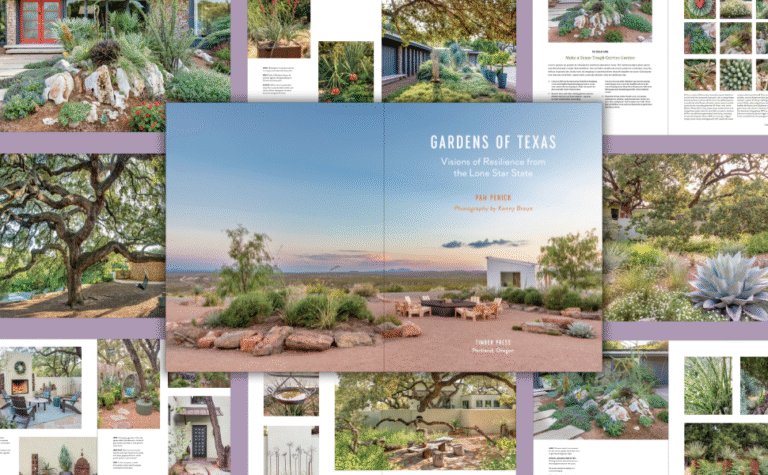In her article, 32 Plants for Sun and Shade That the Deer Won’t Devour, author Karen Chapman discusses the increase in deer venturing into gardens for their next meal: “Deer have always munched on garden plants, but due to continued loss of habitat and natural predators, deer populations and their garden-devouring forays are on the rise across the United States and Canada.” As these hungry herbivores become more bold and brazen in our gardens, we must learn to cohabitate while not having to sacrifice on exciting and diverse plant palettes.
If your favorite perennial also happens to be a favorite meal for your local deer population, our regional experts from across North America have great alternatives that won’t be so appetizing. Click on your region below to see four great deer-resistant perennials specifically selected for your area, or scroll through the whole list to find endless inspiration for designs deer won’t eat.
Pacific Northwest
Black Pearl euphorbia
Name: Euphorbia characias ‘Black Pearl’
Zones: 6–10
Size: 1 to 3 feet tall and 2 to 4 feet wide
Conditions: Full sun to partial shade; well-drained soil
Native range: Southern Europe and Turkey
This drought-tolerant euphorbia delights gardeners, but deer tend to steer clear. Apart from its herbivore resistance, there is so much more to admire about this fabulous, low-maintenance, sun-loving perennial. Gray-green whorls of foliage are topped with long-lasting, vibrant chartreuse flower clusters in late winter. Each bright bloom has a deep burgundy, almost black center. ‘Black Pearl’ thrives in full sun to partial shade and makes a wonderful addition to mixed borders and rock gardens. Like all euphorbias, careful handling of this plant is important because of its irritating, caustic, milky sap.
‘Pacific Frost’ hellebore
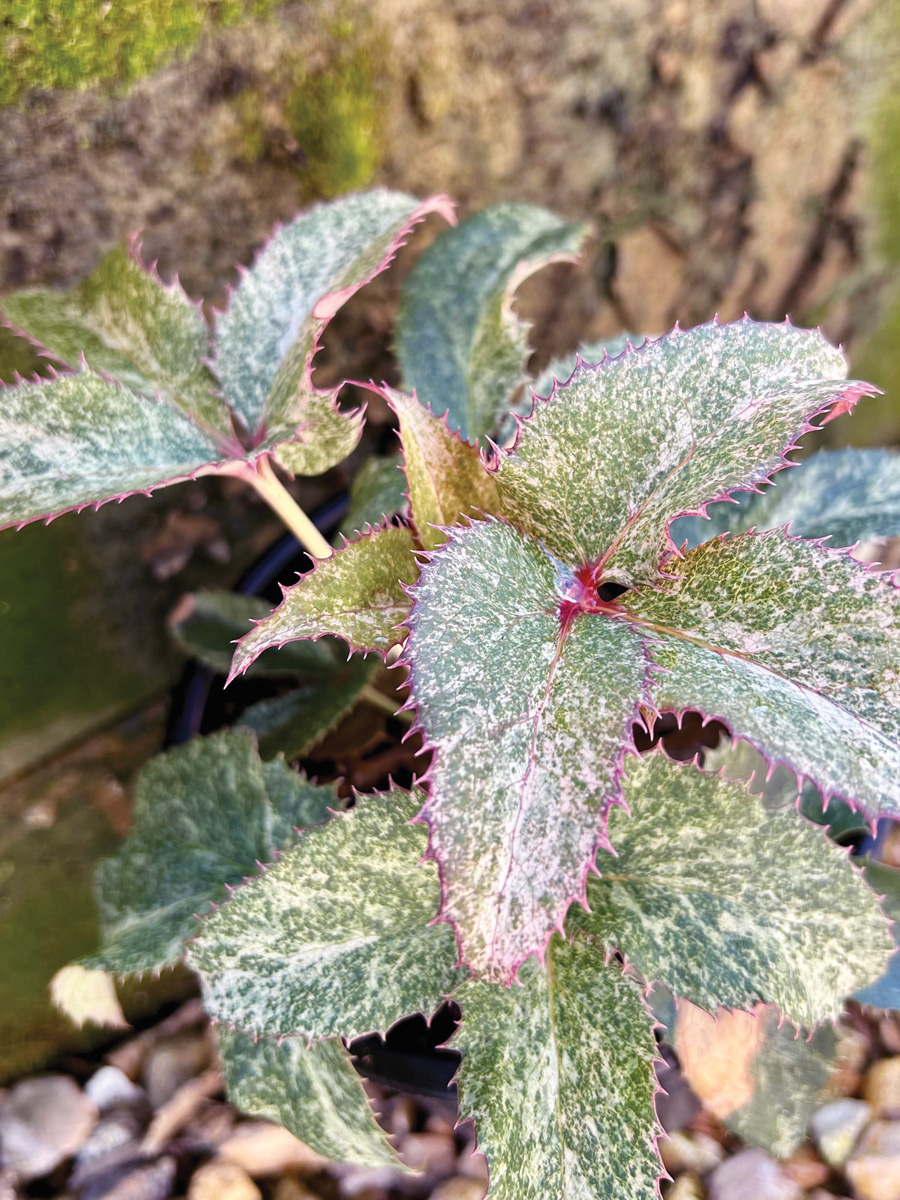
Name: Helleborus argutifolius ‘Pacific Frost’
Zones: 6–9
Size: 1½ to 3 feet tall and 1 to 2 feet wide
Conditions: Partial to full shade; moist, well-drained soil
Native range: Corsica and Sardinia
With its gorgeously marbled cream-and-green foliage, this rugged, easy-care perennial is a must-have for any deer-resistant landscape. Showy, nodding, cup-shaped blooms appear in late winter and last into spring. Even without the flowers, which are a greenish-ivory and mature to a dusky pink or even purple, this plant is stunning. Its foliage adds colorful and textural interest all year long. Like most drought-tolerant plants, ‘Pacific Frost’ hellebore appreciates well-drained soil. It will happily reach around 18 inches tall and up to 3 feet tall when in bloom. Be sure to provide afternoon shade for best results.
‘Flock of Flamingos’ penstemon
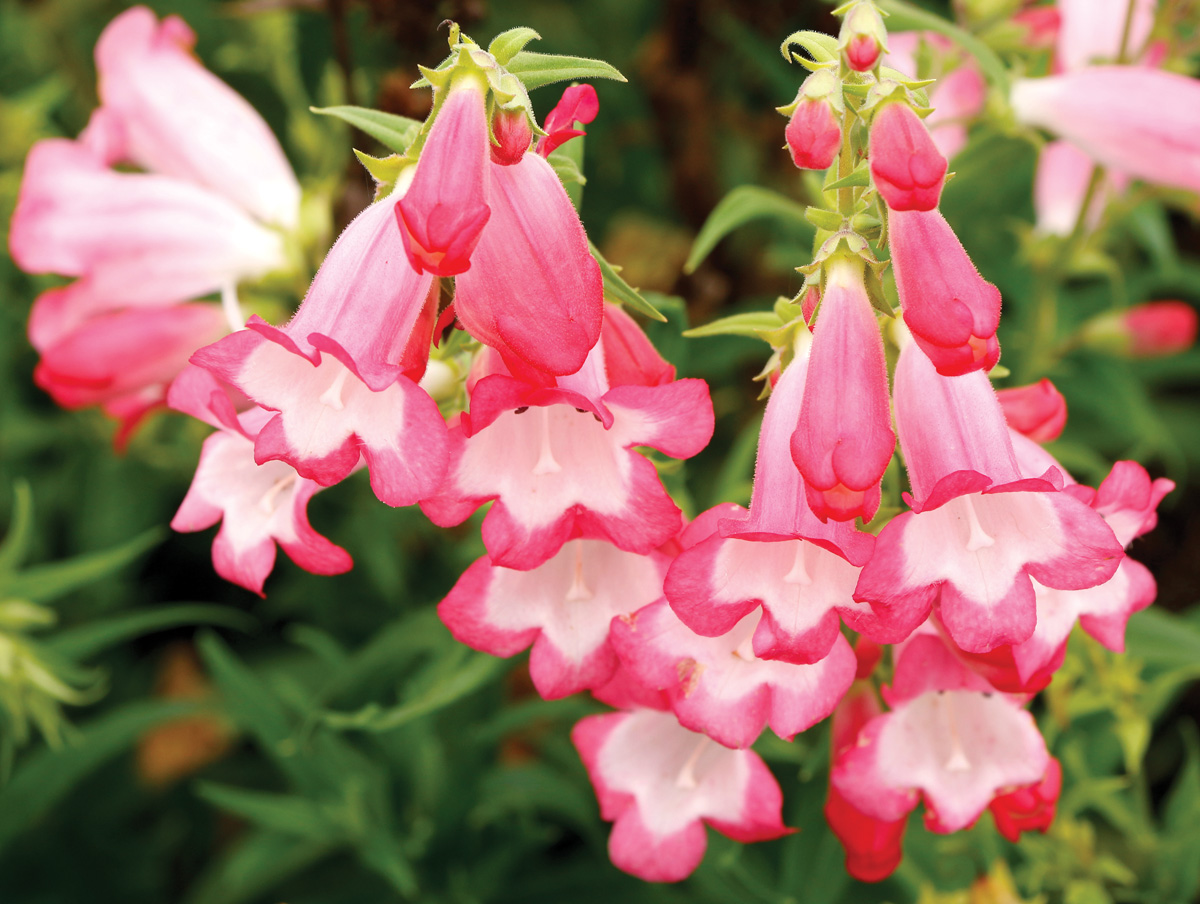
Name: Penstemon ‘Flock of Flamingos’
Zones: 6–9
Size: 1 to 3 feet tall and 1 to 1½ feet wide
Conditions: Full sun; well-drained soil
Native range: Hybrid
‘Flock of Flamingos’ is a very apt name for this charming perennial. Pollinators flock to the tubular coral-pink blooms that open up all along the sturdy, upright stalks. Flowering from spring through summer, this penstemon’s dense, apple green, lance-shaped leaves highlight the blooms perfectly. This plant looks outstanding in a mixed border, fabulous in mass plantings, and lovely potted up in your favorite container. Providing full sun is important, as well as rich, well-drained soil and regular irrigation. With the right conditions, this perennial will reach around 3 feet tall in full bloom. Cut it back hard in late winter to encourage bushy new growth and lots of bloom spikes.
‘Silver Queen’ ajuga
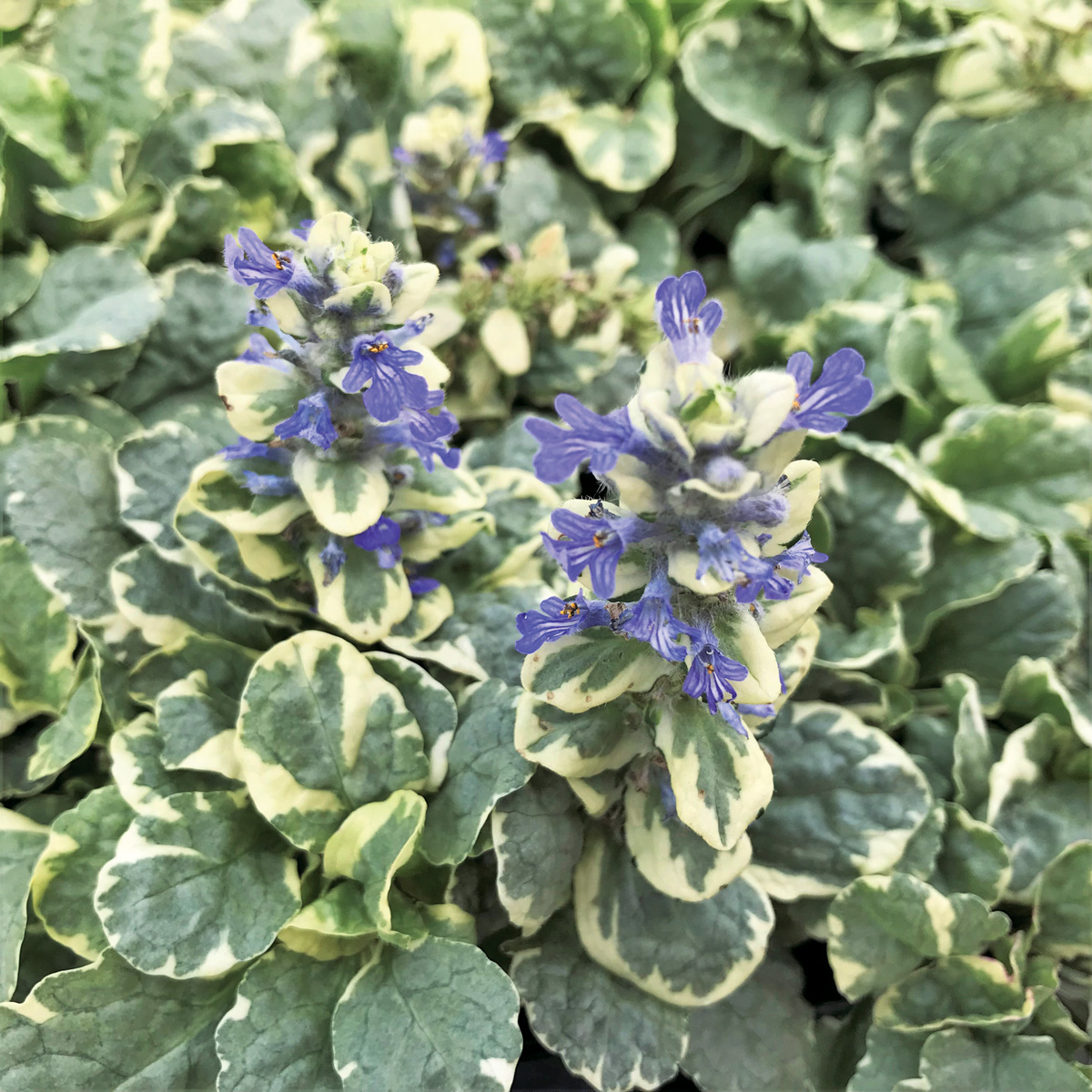
Name: Ajuga reptans* ‘Silver Queen’
Zones: 3–9
Size: 4 to 8 inches tall and 8 to 12 inches wide
Conditions: Full sun to full shade; average to moist, well-drained soil
Native range: Europe, northern Africa, and southwestern Asia
This bright and cheery plant forms attractive rosettes of round, cream-splashed silvery-green foliage that looks scalloped. It’s adorned with short spikes of violet-blue flowers from spring through summer. Tolerant of most soils, ‘Silver Queen’ prefers afternoon shade in Northern California, but can take more sun in cooler climes. Regular irrigation is always appreciated, allowing it to spread quickly and beautifully to edge walkways, blanket bare spots, or brighten shady corners. It also works well in pots, window boxes, or hanging baskets, and makes a stunning underplanting for camellias (Camellia spp. and cvs., Zones 6–10) and Japanese maples (Acer palmatum and cvs., Zones 5–9). *Check invasive alerts for ajuga in your area before planting.

Regional expert: Fionuala Campion is the owner and manager of Cottage Gardens of Petaluma in Petaluma, California, and is a regional reporter at FineGardening.com.
Southwest
‘Orange Peel’ cestrum
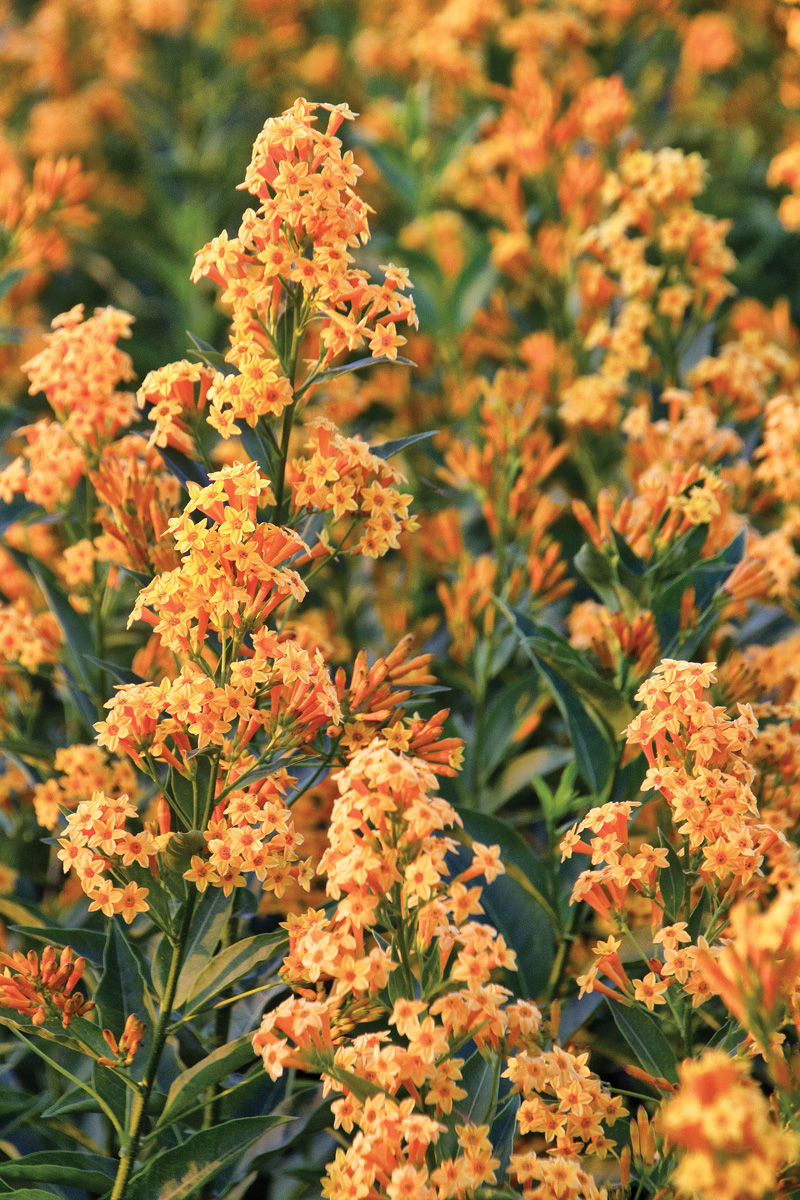
Name: Cestrum ‘Orange Peel’
Zones: 7–9
Size: 4 to 6 feet tall and wide
Conditions: Full sun; well-drained soil
Native range: Hybrid
This giant, drought-tolerant perennial blooms from late spring through frost, producing sweet-smelling clusters of tubular orange flowers that are always crowded with butterflies, native bees, and hummingbirds. Create an evening oasis with these citrus-scented blossoms, which are most fragrant at night. Cestrum is considered toxic to deer as well as people and pets, so plan accordingly. Protect the crown with a heavy layer of winter mulch in Zone 7, where ‘Orange Peel’ behaves as a dieback perennial. Plants quickly regrow from the roots to reach heights of around 5 feet in a single season. In warmer zones, it will grow as a deciduous shrub.
‘Sol Dancer’ four-nerve daisy
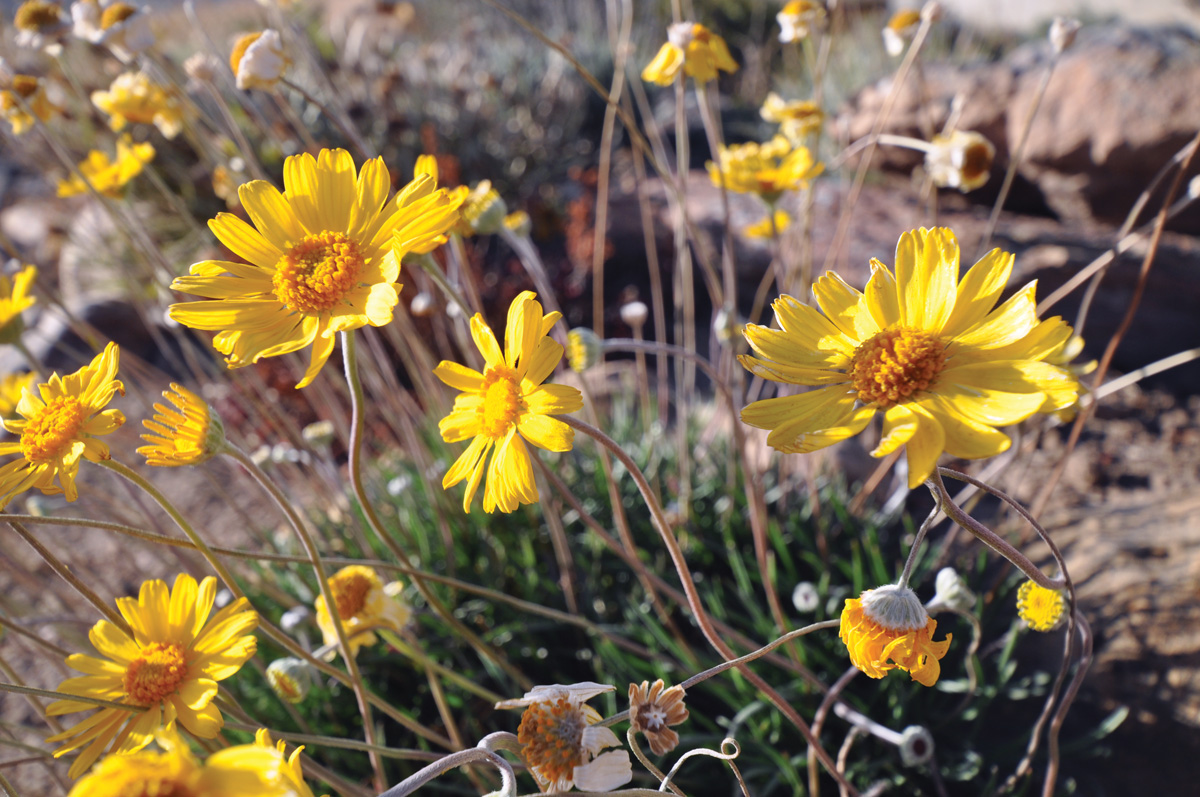
Name: Tetraneuris acaulis var. arizonica ‘Sol Dancer’
Zones: 4–10
Size: 12 to 18 inches tall and wide
Conditions: Full sun; lean, dry, well-drained soil
Native range: Western United States
‘Sol Dancer’ four-nerve daisy grows as a tidy mound of fine, grasslike foliage that sports a profusion of yellow blooms. Flowers stand on sturdy stems above the leaves, providing nectar to pollinators from late spring through fall. A cultivar of a western foothill native plant, ‘Sol Dancer’ performs wonderfully in rock gardens, xeric landscapes, and as an edging plant in beds and borders. It thrives in sunny, hot sites in any well-draining soil, though it is most at home in lean, rocky substrates. Mulch with gravel to improve plant performance. Four-nerve daisy is highly resistant to browsing by rabbits and deer.
Orange Carpet® hummingbird trumpet
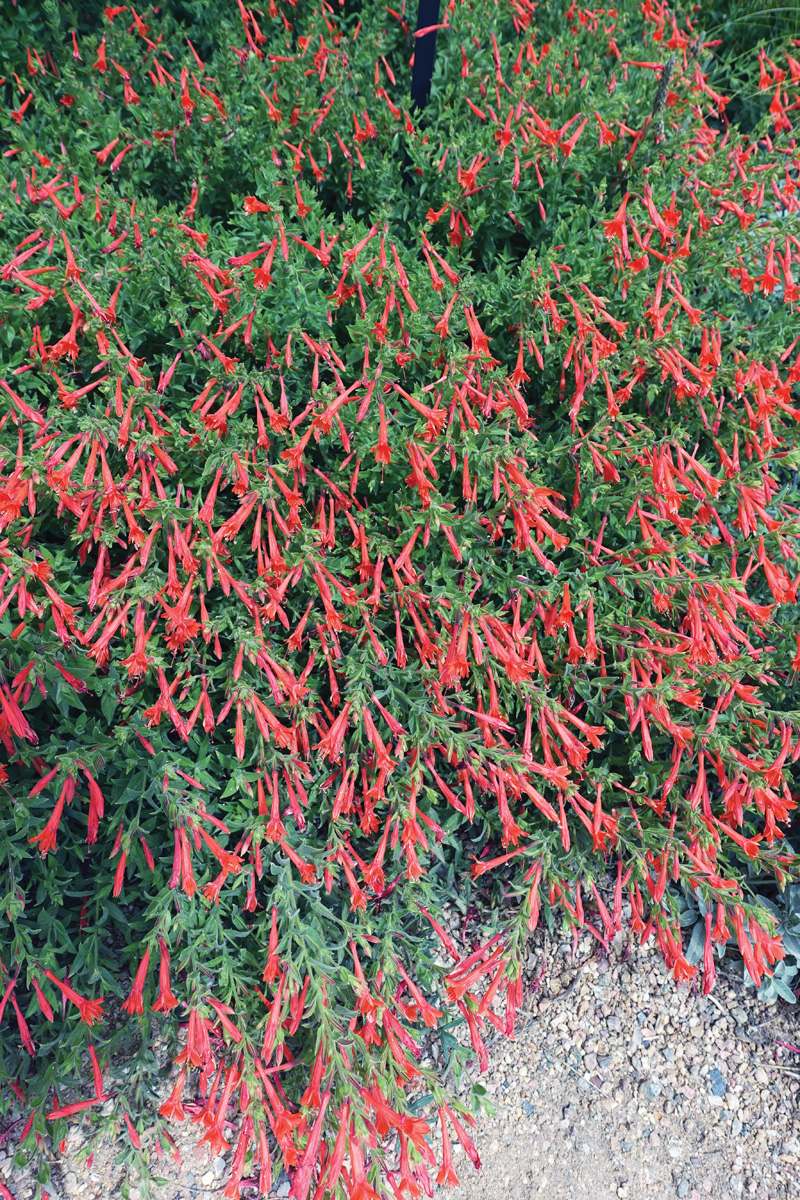
Name: Epilobium canum subsp. garrettii ‘PWWG01S’
Zones: 3–8
Size: 4 to 6 inches tall and 18 to 24 inches wide
Conditions: Full sun to partial shade; lean, dry to medium, well-drained soil
Native range: Western United States
Hummingbird trumpet typically blooms from late summer to mid-fall, but the stunning floral display is worth the wait. As other plants succumb to the heat of summer, its dazzling trumpet-shaped flowers act as magnets to hummingbirds, fueling their southward migrations. Orange Carpet® has a low, mounding habit and spreads via rhizomes, providing excellent erosion control. It thrives at higher elevations and is drought tolerant once established. This perennial looks gorgeous spilling over stone walls and grows beautifully in rock gardens or massed as a ground cover.
‘Artic Glow’ great globe thistle
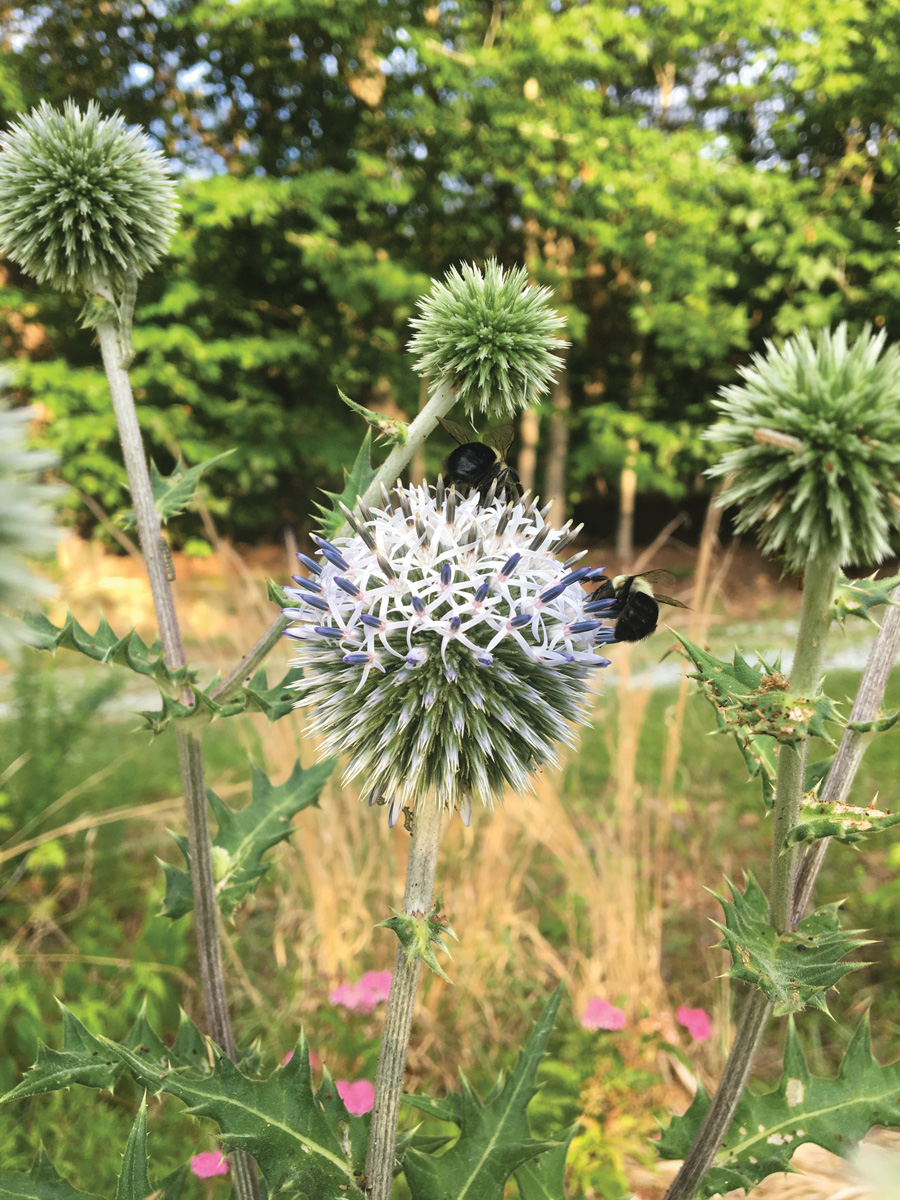
Name: Echinops sphaerocephalus ‘Arctic Glow’
Zones: 3–10
Size: 30 to 36 inches tall and 9 to 18 inches wide
Conditions: Full sun; dry to medium, well-drained soil
Native range: Europe and western Asia
The golf ball–sized spheres of densely packed, starshaped flowers on ‘Arctic Glow’ great globe thistle delight gardeners and pollinators alike. White flower heads emerge in mid- to late summer, drawing scores of bees and butterflies. These glowing blooms contrast strikingly with the hairy reddish stems and deeply dissected, silver-green foliage below. They also make wonderful cut flowers and dry well if you cut them before they open and then hang them upside down. Deadheading extends the bloom period, though the plant will reseed if left uncut and spent blooms will stand long after flowering, adding texture to late-season designs. ‘Arctic Glow’ will tolerate poor, rocky soils and periods of drought.

Regional expert: Kim Toscano is a horticulturist, entomologist, garden designer, writer, and garden illustrator. She is also a Southwest regional reporter at FineGardening.com.
Mountain West
‘Sarah Bernhardt’ peony
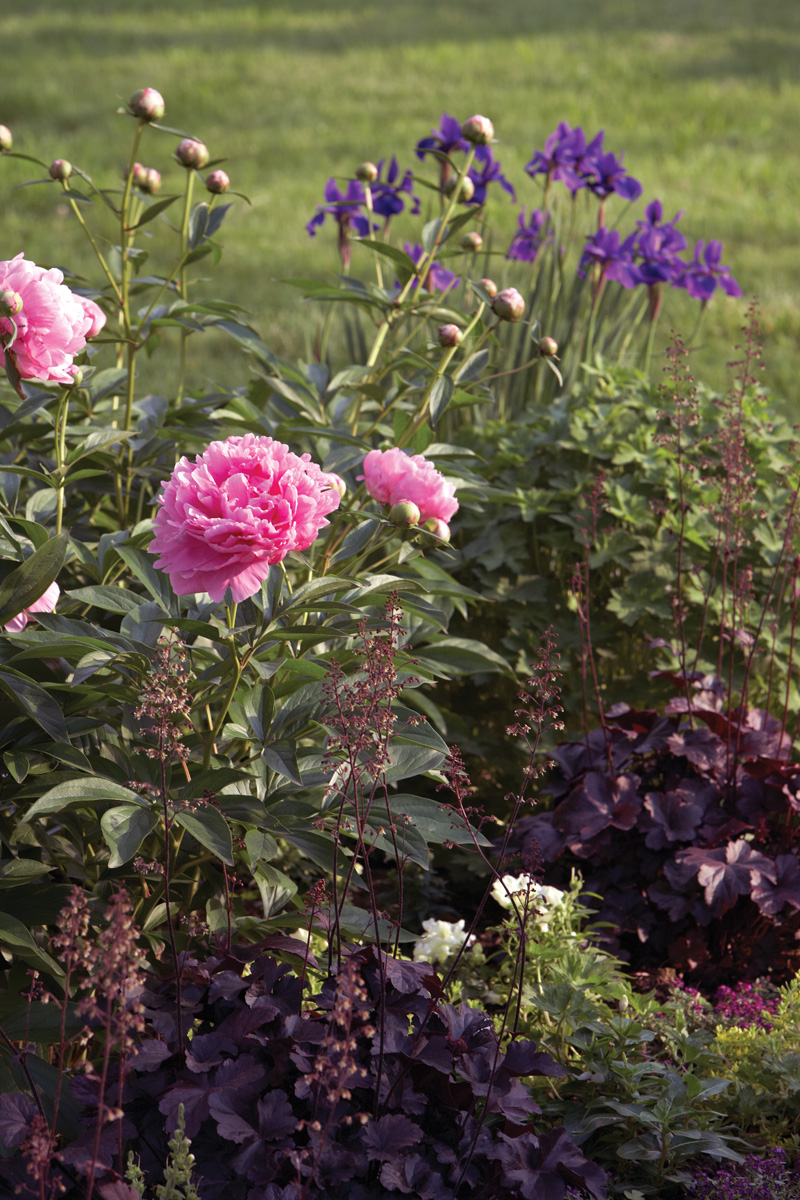
Name: Paeonia lactiflora ‘Sarah Bernhardt’
Zones: 3–8
Size: 30 to 36 inches tall and wide
Conditions: Full sun to partial shade; well-drained soil
Native range: Central Asia
‘Sarah Bernhardt’ remains a timeless classic for its generous bounty of large pastel-pink double flowers that open from late spring to early summer. The fragrant blooms look just as good in a vase as they do in the ground and are among our region’s largest garden flowers, regardless of the season. Peony plants are slow to establish, but in the right conditions will enjoy long lifespans that would be more typical for woody shrubs. There are peonies in my family that have been passed down for over three generations. Despite their lush appearance and glossy cut foliage that remains attractive until frost, peonies are tough, adaptable, and deer resistant, and they will thrive with moderate watering.
‘Select Blue’ catmint
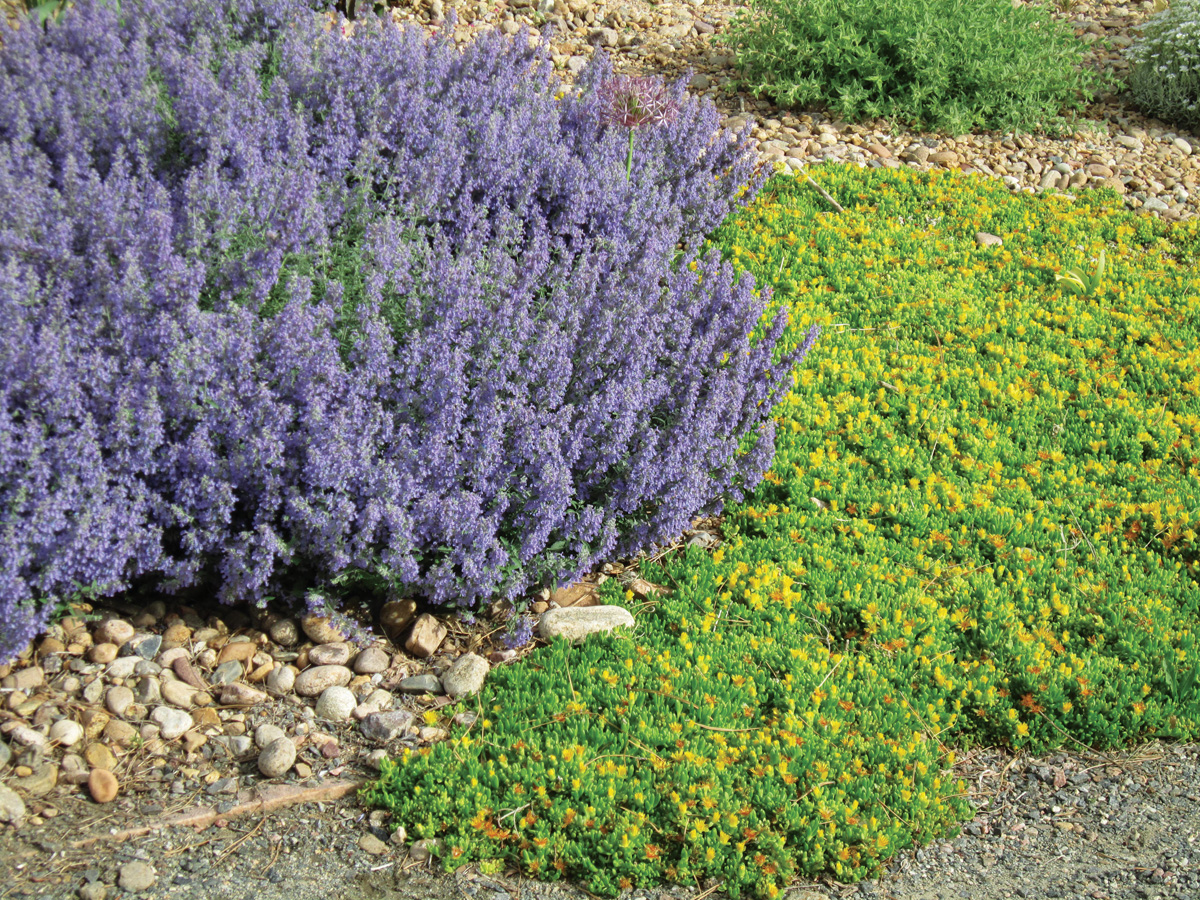
Name: Nepeta × faassenii ‘Select Blue’
Zones: 4–8
Size: 12 to 18 inches tall and 12 to 24 inches wide
Conditions: Full sun to partial shade; average to dry, well-drained soil
Native range: Hybrid of European species
Catmint has achieved classic status in Rocky Mountain gardens thanks to its easy disposition and reliable summer-long display of small violet-colored flowers. Some catmint cultivars have problematic characteristics: Fertile selections self-seed enthusiastically or even aggressively, while many sterile forms, like ‘Walker’s Low’, grow tall and then flop, splaying in the center and requiring a cutback. ‘Select Blue’ is a somewhat newer cultivar that addresses both of these issues. It is sterile and has a compact growing habit that rarely splays. Bred for a more true blue flower and reliable rebloom, it is an aesthetic standout from May through September.
Anise hyssop
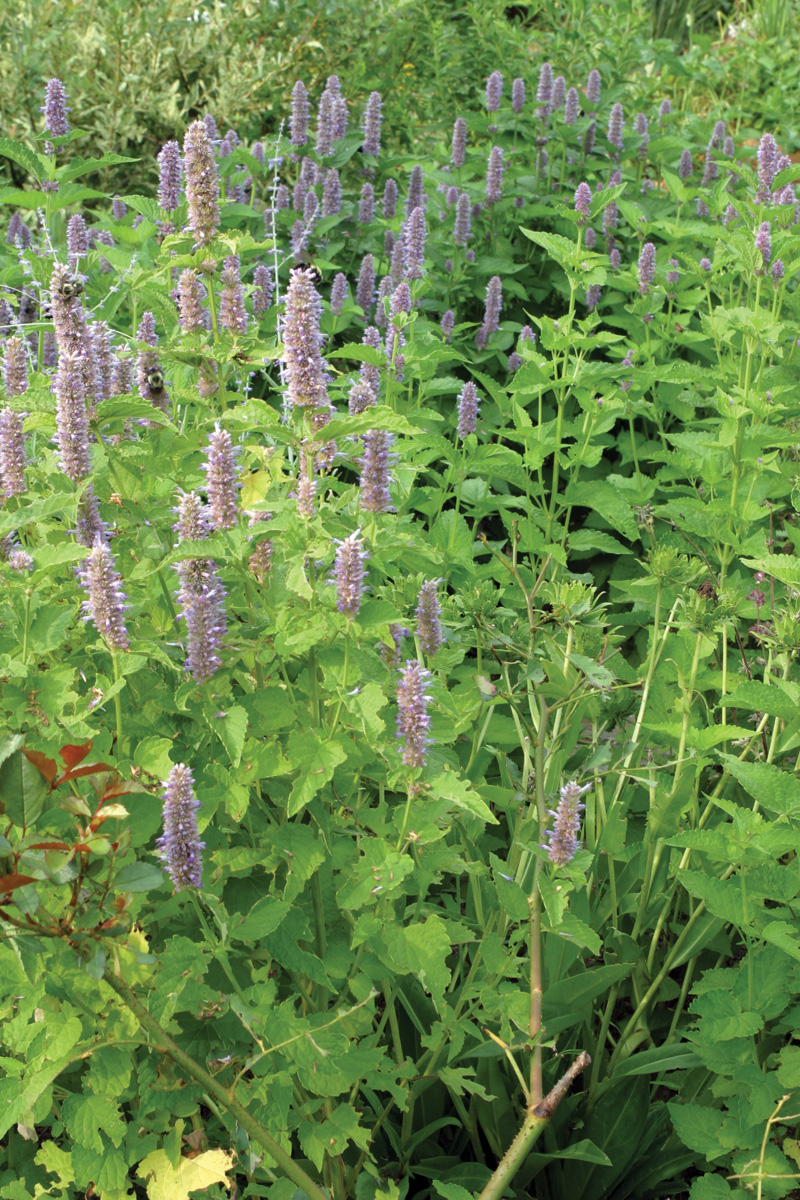
Name: Agastache foeniculum
Zones: 3–8
Size: 3 to 4 feet tall and 2 to 3 feet wide
Conditions: Full sun to partial shade; dry to average, well-drained soil
Native range: Northern North America
Native to both the Great Plains and the Rockies, this plant is enjoying a moment in native plant gardening circles. It is attractive and presents well from spring through fall, with arrowhead-shaped leaves arranged on tall square stems. In midsummer, when many other perennials begin to look tired, anise hyssop produces spikes of blue-purple flowers that simply glow in morning and evening light. This species is a particular favorite of songbirds, which perch on the stout stems to enjoy he small black seeds that develop after the
blooms fade. As one of the most adaptable of Agastache species, it thrives in warmer plains gardens and cooler mountain locales.
Geyer’s larkspur
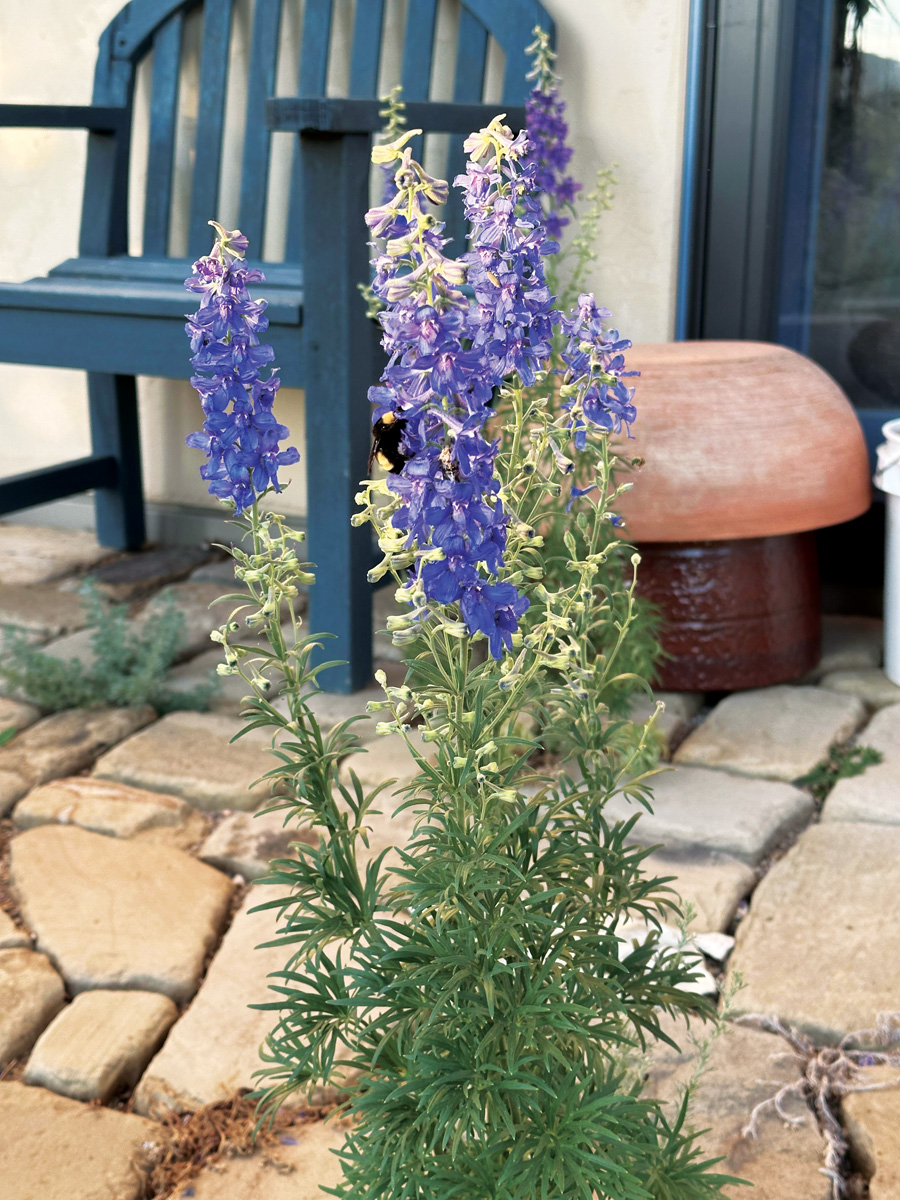
Name: Delphinium geyeri
Zones: 3–8
Size: 2 to 4 feet tall and 1 to 2 feet wide
Conditions: Full sun; well-drained soil
Native range: Colorado, Nebraska, Utah, and Wyoming
Continuing our celebration of cool-hued blooms, Geyer’s larkspur brings the color intensity to a new level with spectacular cobalt blue spikes of intricate, five-petaled flowers. The plants are slow to establish but make up for this by being long-lived and extremely drought tolerant. They are native to grasslands and shrublands throughout our region, where they can be seen blooming, sometimes in great numbers, at the onset of true summer. Despite the easy-going nature of this plant once it is established, it’s extremely intolerant of root disturbance. Therefore, transplanting is not the most effective method to incorporate it into your garden. Instead, scratch seeds into the soil in fall and be patient. Seedlings with finely cut, lacy foliage will follow.

Regional expert: Bryan Fischer lives and gardens at the intersection of the Great Plains and the Rockies and is the Mountain West regional reporter at FineGardening.com.
Midwest
Butterfly weed
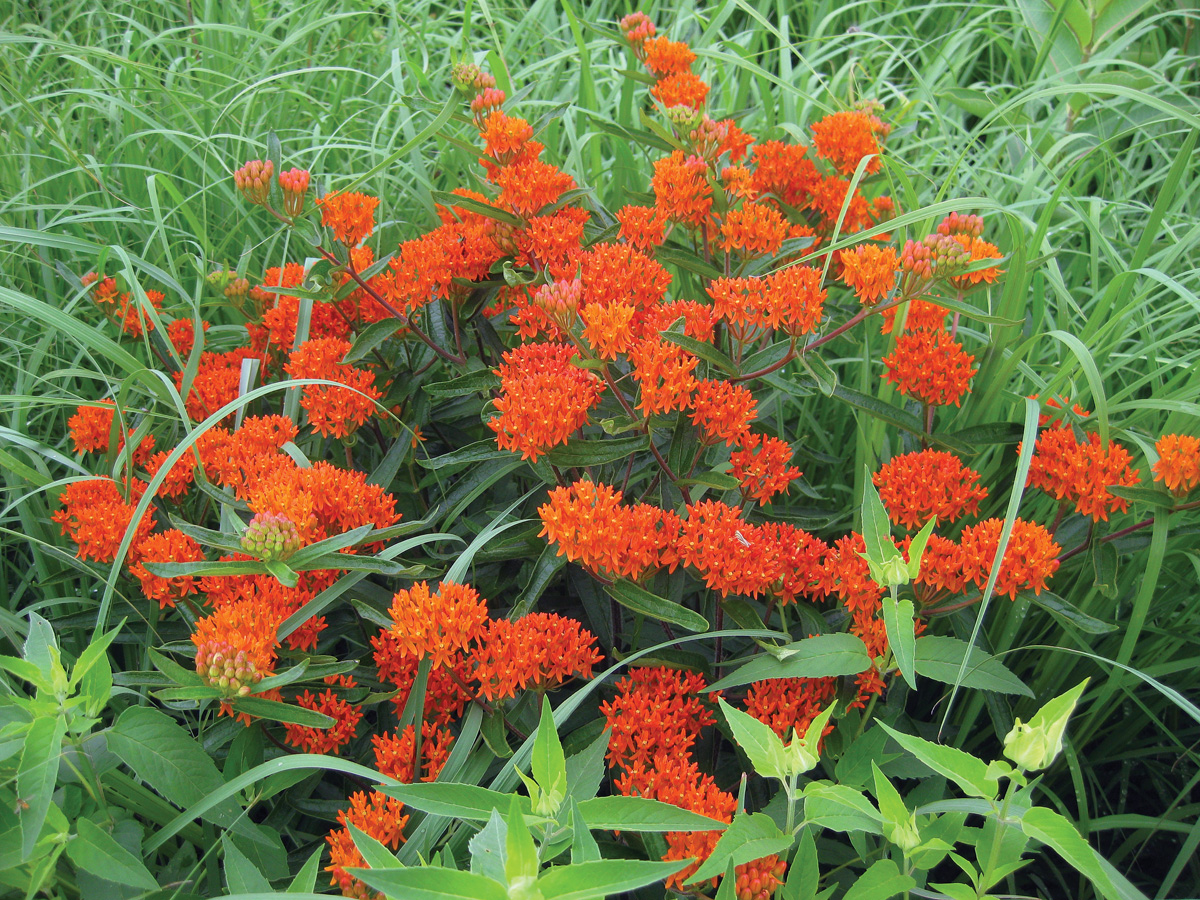
Name: Asclepias tuberosa
Zones: 3–9
Size: 18 to 30 inches tall and 12 to 18 inches wide
Conditions: Full sun to partial shade; well-drained soil
Native range: North America
Butterfly weed has an impressively broad native range that extends from Eastern Canada across most of the United States and into Northern Mexico. Like other milkweeds, it has bitter toxins in its stems and leaves that keep it safe from deer browsing. In addition to this garden-worthy attribute, it is low-maintenance, durable, and long blooming. Flat-topped clusters of red, orange, and yellow flowers open from late June into August, supporting a wide range of pollinators. While the plant isn’t likely to sustain deer or rabbit damage, it is a suitable host for monarch butterfly larvae, so don’t be alarmed if you occasionally find a striped caterpillar nibbling on its leaves.
Leadplant
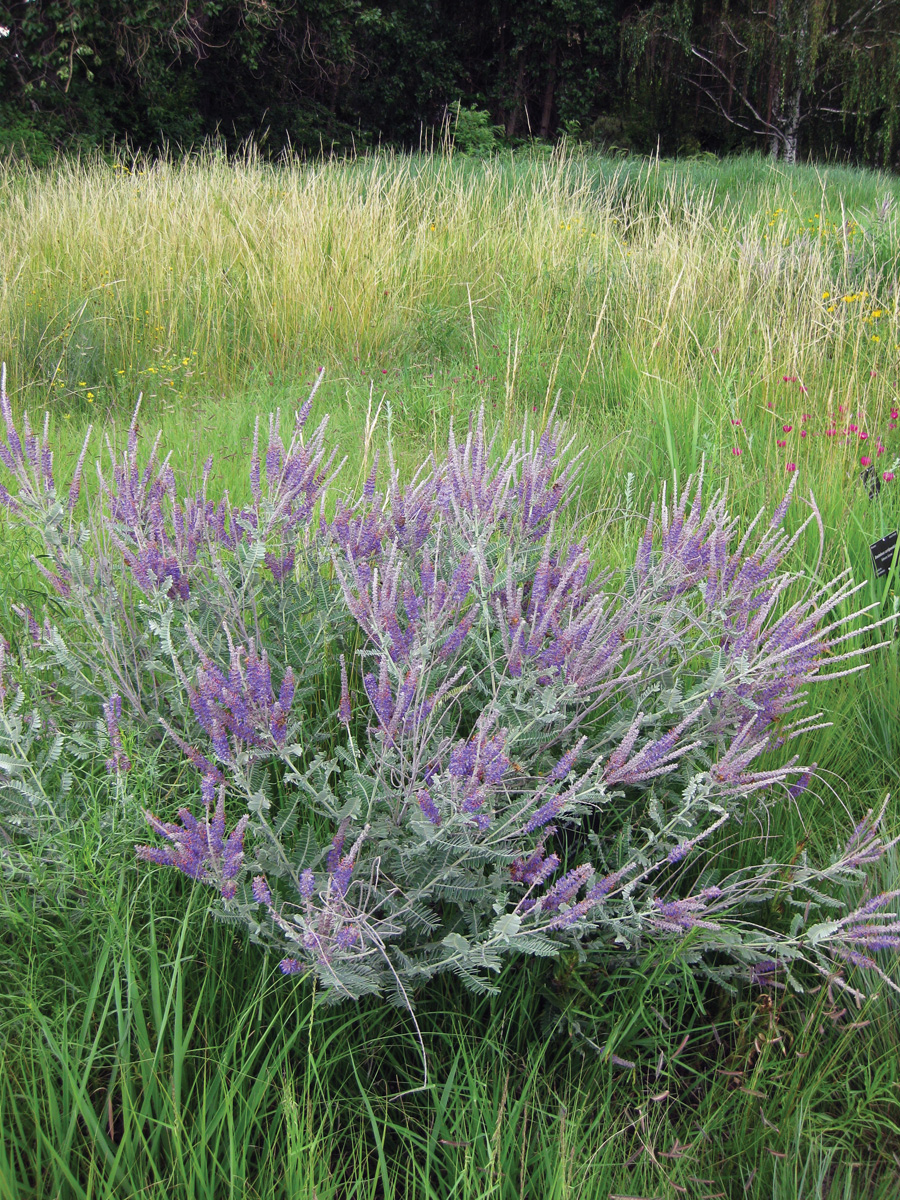
Name: Amorpha canescens
Zones: 3–9
Size: 2 to 3 feet tall and wide
Conditions: Full sun; dry to medium, well-drained soil
Native range: Central United States and Canada
This native legume is technically a woody plant, although it will generate new growth from ground level that grows to about 3 feet tall in a season. Silvery leaves are topped by spikes of densely packed purple-blue flowers that are an important nectar source for native pollinators from mid- to late summer. On top of its good looks and pollinator power, leadplant has deep roots that make it drought tolerant, low-maintenance, and an effective choice for erosion control. With its moderate size and adaptability, it can easily be placed in most Midwest gardens. Mature plants are very deer resistant, but try to give new plants some protection from rabbits until they are established.
‘Sterling Silver’ brunnera
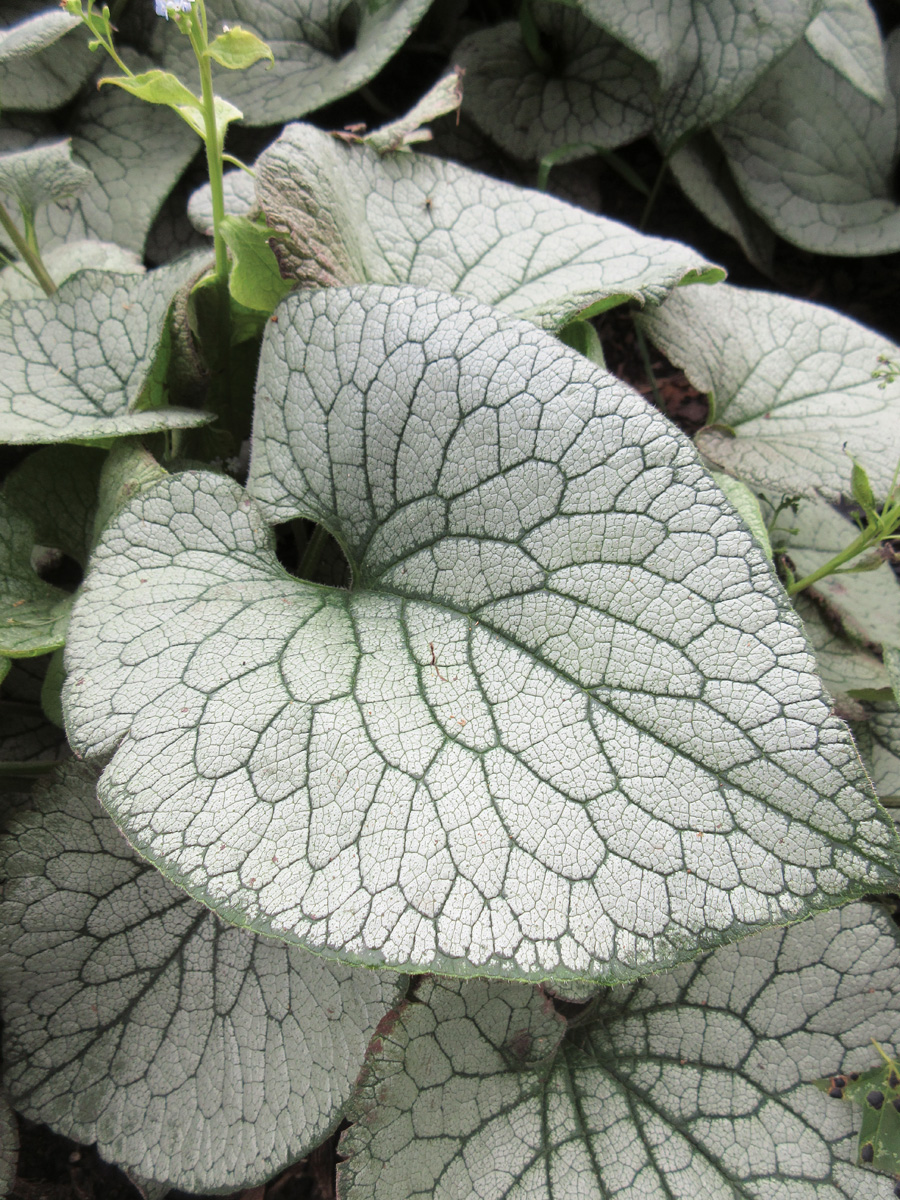
Name: Brunnera macrophylla ‘Sterling Silver’
Zones: 3–8
Size: 12 to 18 inches tall and 18 to 30 inches wide
Conditions: Partial shade; moderately moist, well-drained soil
Native range: Turkey
Brunneras are indispensable shade plants with many varieties featuring beautiful white or silver highlights on their large, heart-shaped leaves. ‘Sterling Silver’ is especially striking, with heavily variegated foliage that appears almost entirely silver. It offers improved heat tolerance and a larger, more robust habit than some of the older variegated cultivars. In early spring, bright new foliage provides a glittering backdrop for sprays of sky blue flowers. Remove the faded flower stems to encourage continued blooming. All brunneras have leaves with a sandpaper-like texture that discourages nibbling from most critters and insects. Try massing it as a unique ground cover or tuck it into a container.
Pennsylvania sedge
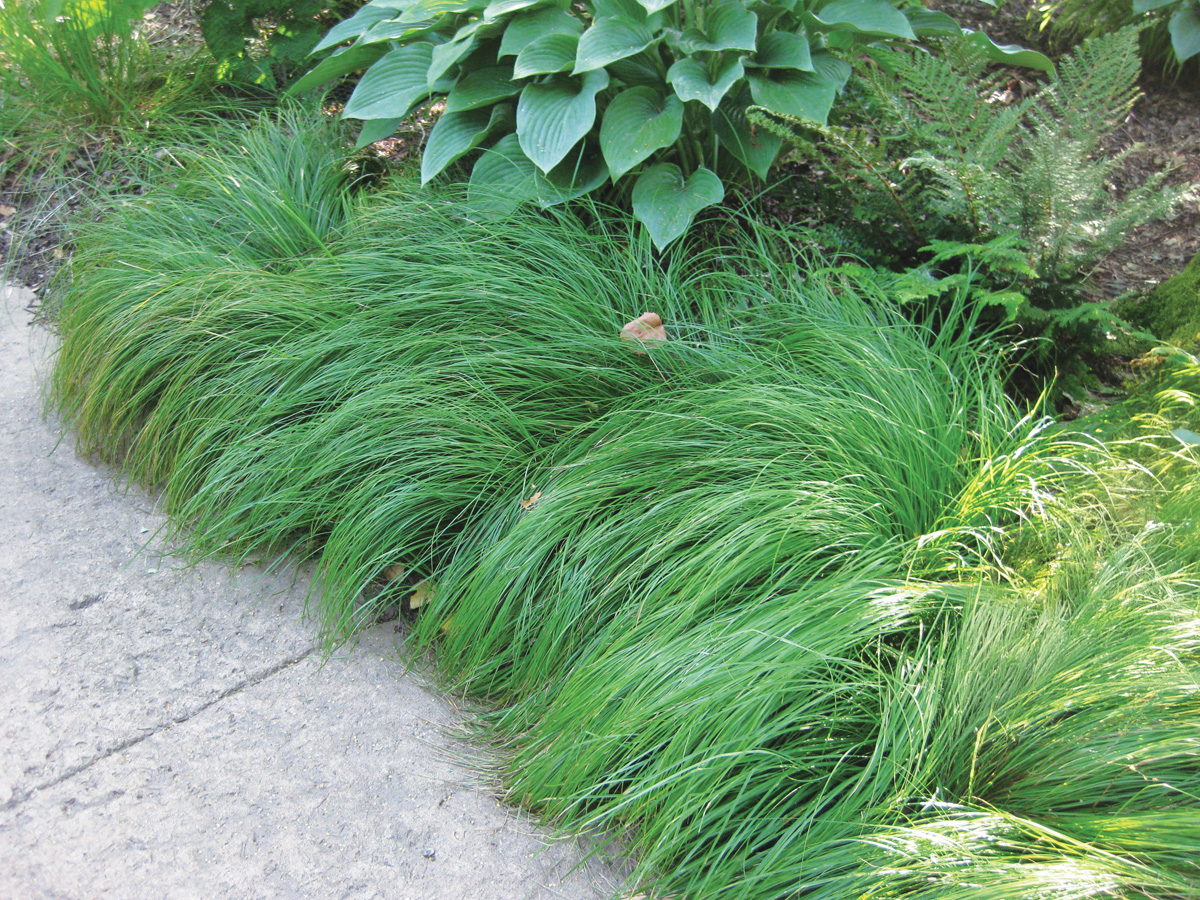
Name: Carex pensylvanica
Zones: 3–8
Size: 10 to 12 inches tall and 12 to 18 inches wide
Conditions: Full sun to full shade; moist to dry, well-drained soil
Native range: Eastern and central United States and Canada
Many sedges (Carex spp. and cvs., Zones 3–10) are deer resistant, and worth exploring for their value as ground covers and textural landscape elements. Pennsylvania sedge has a soft texture that works well for filling in the gaps between taller plants, and it makes a fine turf alternative. What this sedge lacks in showiness it makes up for in adaptability and hardiness. While many sedges prefer moist to wet habitats, this species does best in drier soil and can easily handle periods of drought. It will also tolerate regular moisture in well drained soil. Plant Pennsylvania sedge in dense shade or sun, keeping in mind that plants in sunnier locations will require more moisture.

Regional expert: Mark Dwyer is the garden manager for the Edgerton Hospital Healing Garden in Edgerton, Wisconsin, and he operates Landscape Prescriptions by MD. He is also a regional reporter for FineGardening.com
Southeast
‘Gold Heart’ bleeding heart
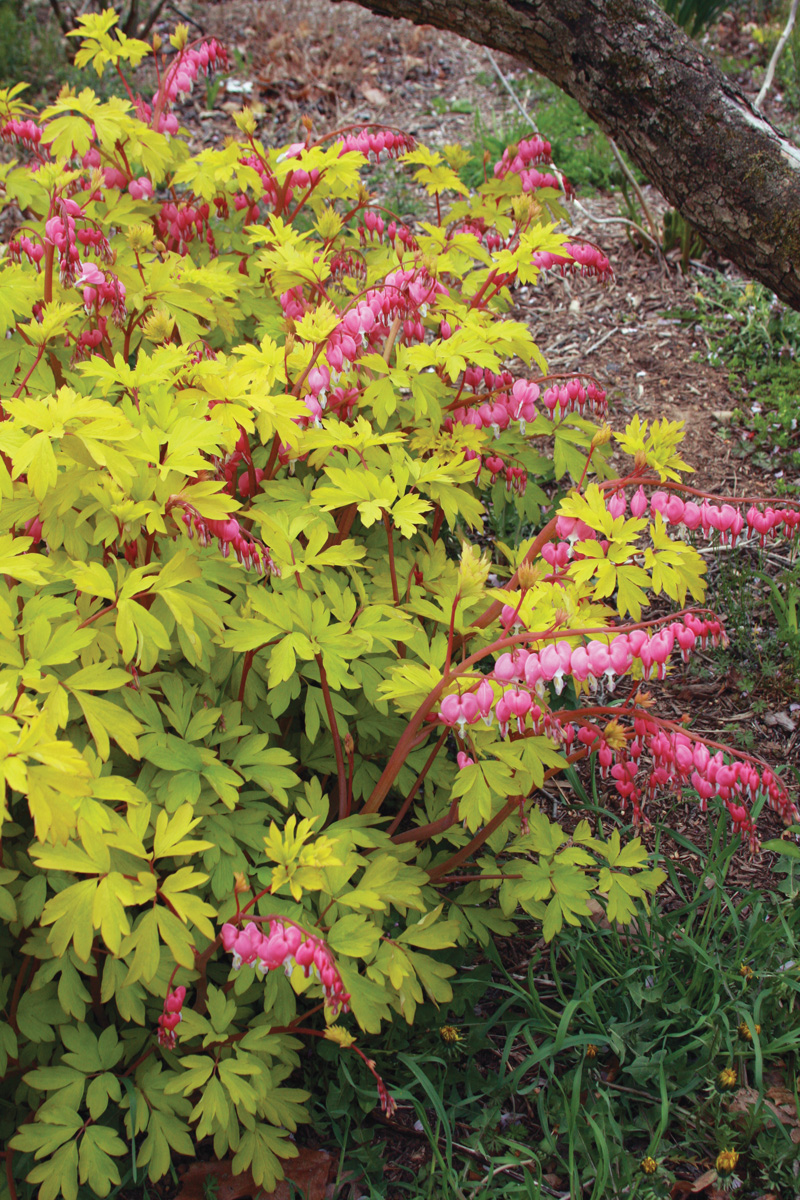
Name: Lamprocapnos spectabilis ‘Gold Heart’
Zones: 3–9
Size: 1½ feet to 2 feet tall and 2 to 3 feet wide
Conditions: Partial to full shade; moist, well-drained soil
Native range: Eastern Asia
In my garden, each inch of shade is precious, so not every plant makes the cut. But a shade plant I wouldn’t be without is ‘Gold Heart’ bleeding heart. This deer-resistant perennial thrives in woodland areas. In spring, delicate heart-shaped pink flowers contrast beautifully with golden leaves below. The gold coloration will be brightest when the plant gets a few hours of morning sun. Just remember to provide consistent moisture and well-drained soil to keep it happy. Pair it with other shade lovers that will fill in the space during its dormant period. Old-fashioned bleeding hearts are a staple in the Southeast, and this cultivar takes their charm to a new level.
‘Sparkling Burgundy’ pineapple lily
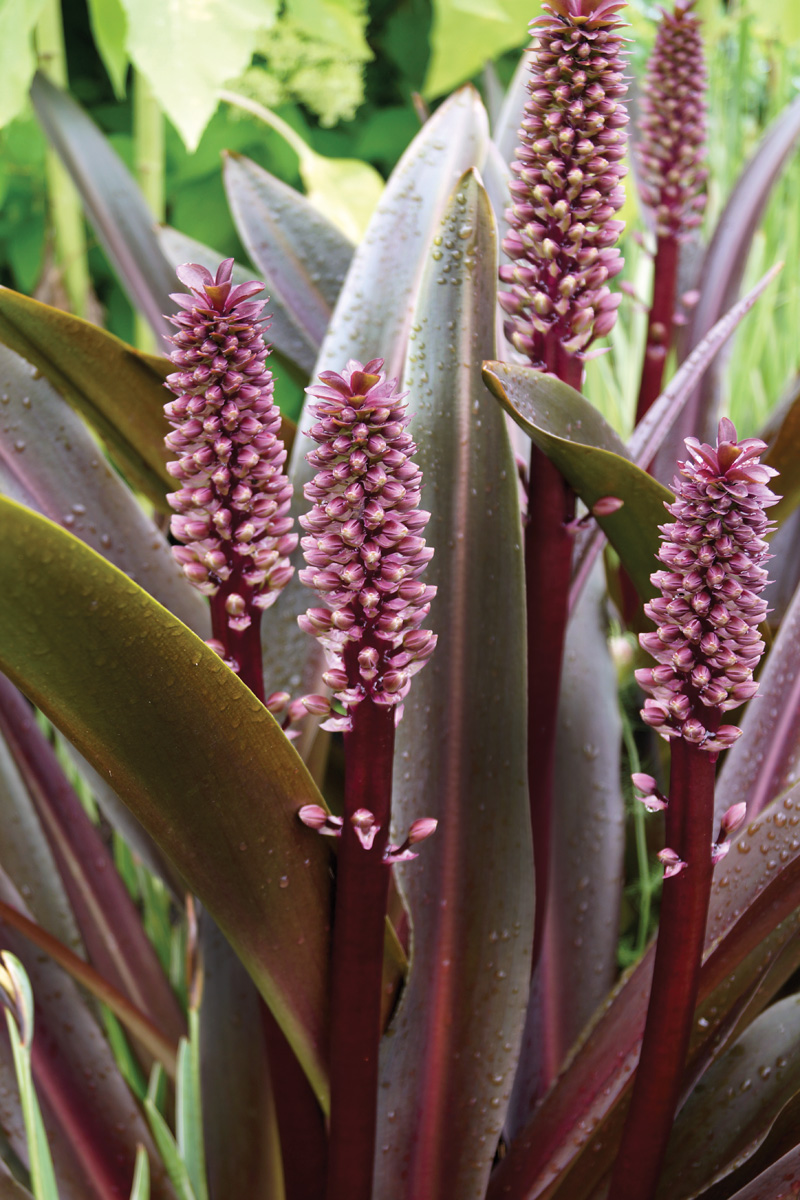
Name: Eucomis comosa ‘Sparkling Burgundy’
Zones: 7–10
Size: 1 to 3 feet tall and wide
Conditions: Full sun to partial shade; average, well-drained soil
Native range: South Africa
‘Sparkling Burgundy’ pineapple lily is a striking head-turner. Deep purple spring foliage is stiff, architectural, and sure to start a conversation. This plant has unique flower spikes topped with clusters of small star-shaped blooms that resemble pineapples on sticks. It grows well in sunny or partially shaded spots and works nicely in containers and borders. Drought tolerant once established, ‘Sparkling Burgundy’ provides tropical flair to your garden and is shunned by deer. Add one plant to make a statement, but install larger groups to really create that wow factor. Pineapple lilies like to remain relatively undisturbed once planted but can be divided in spring as soil temperatures warm and plants start to emerge.
Cherokee sedge
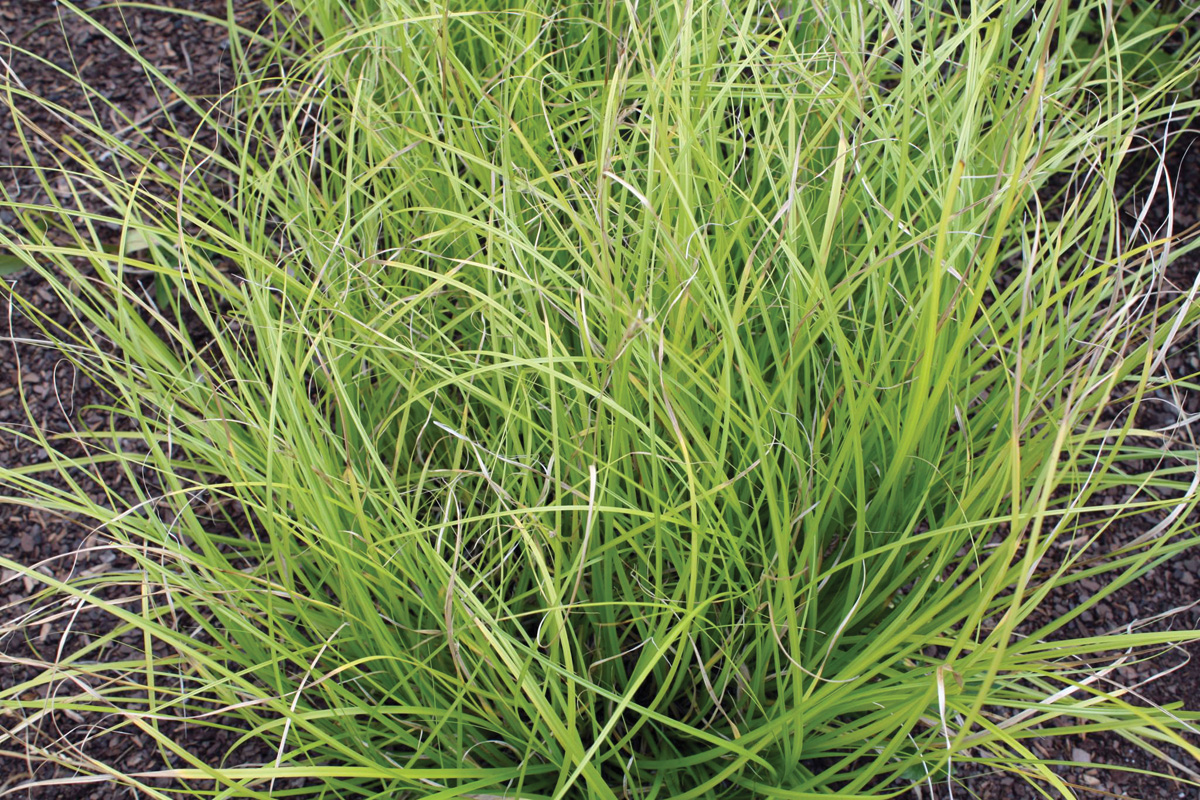
Name: Carex cherokeensis
Zones: 5–9
Size: 12 to 18 inches tall and 18 to 24 inches wide
Conditions: Full sun to full shade; average to moist, well-drained soil
Native range: Southeastern United States
There hasn’t been a plant that has surprised me more over the last few years than Cherokee sedge. This versatile and attractive grasslike
perennial can add texture and softness to a variety of situations. Its narrow, arching leaves have a rich green color that maintains its vibrancy throughout the growing season. Ideal for woodland gardens or for use as a ground cover under trees, this sedge loves moist, well-drained soil but is adaptable to other conditions. It is an excellent choice for adding year-round interest without overwhelming
neighboring plants. It’s also a great low-maintenance alternative to traditional lawn grasses. Cherokee sedge is deer resistant and drought tolerant once established.
‘Butterscotch’ Arkansas bluestar
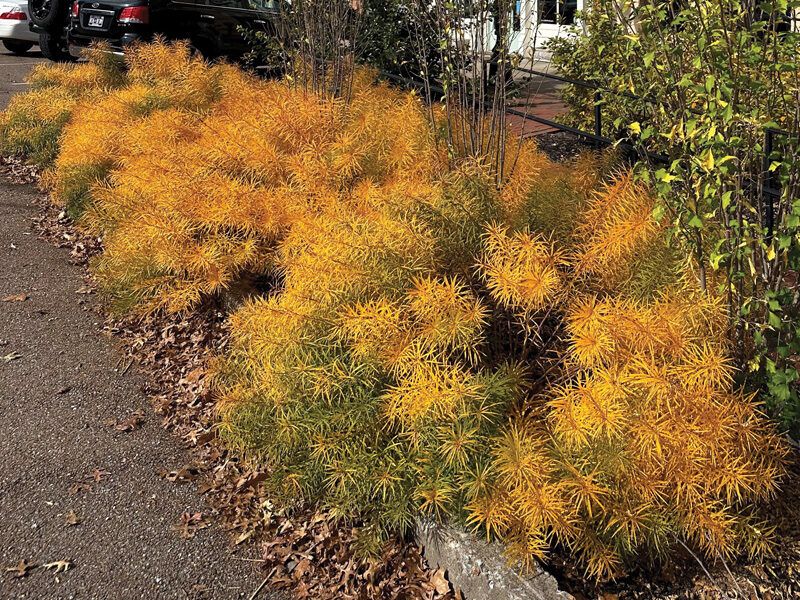
Name: Amsonia hubrichtii ‘Butterscotch’
Zones: 5–8
Size: 2 to 3 feet tall and wide
Conditions: Full sun to partial shade; average to moist, well-drained soil
Native range: Arkansas and Oklahoma
‘Butterscotch’ Arkansas bluestar is a perfect choice if you’re looking for a hardy, drought-tolerant perennial to bring texture and seasonal interest to your garden. This cultivar has soft, feathery foliage that turns a rich golden yellow in fall. Its small starlike blue flowers appear in spring, attracting pollinators. It works well in both sunny spots and areas with some shade. This tough, low-maintenance plant is perfect for naturalistic gardens or border plantings. ‘Butterscotch’ has proven to be a more vigorous grower with improved form and fewer disease problems than the straight species. Its leaves are also slightly wider than the species and will not be a deer’s first choice.

Regional expert: Andy Pulte, PhD, is a faculty member in the plant sciences department at the University of Tennessee. He is also a Southeast regional reporter at FineGardening.com.
Mid-Atlantic
Golden Spirit™ smokebush
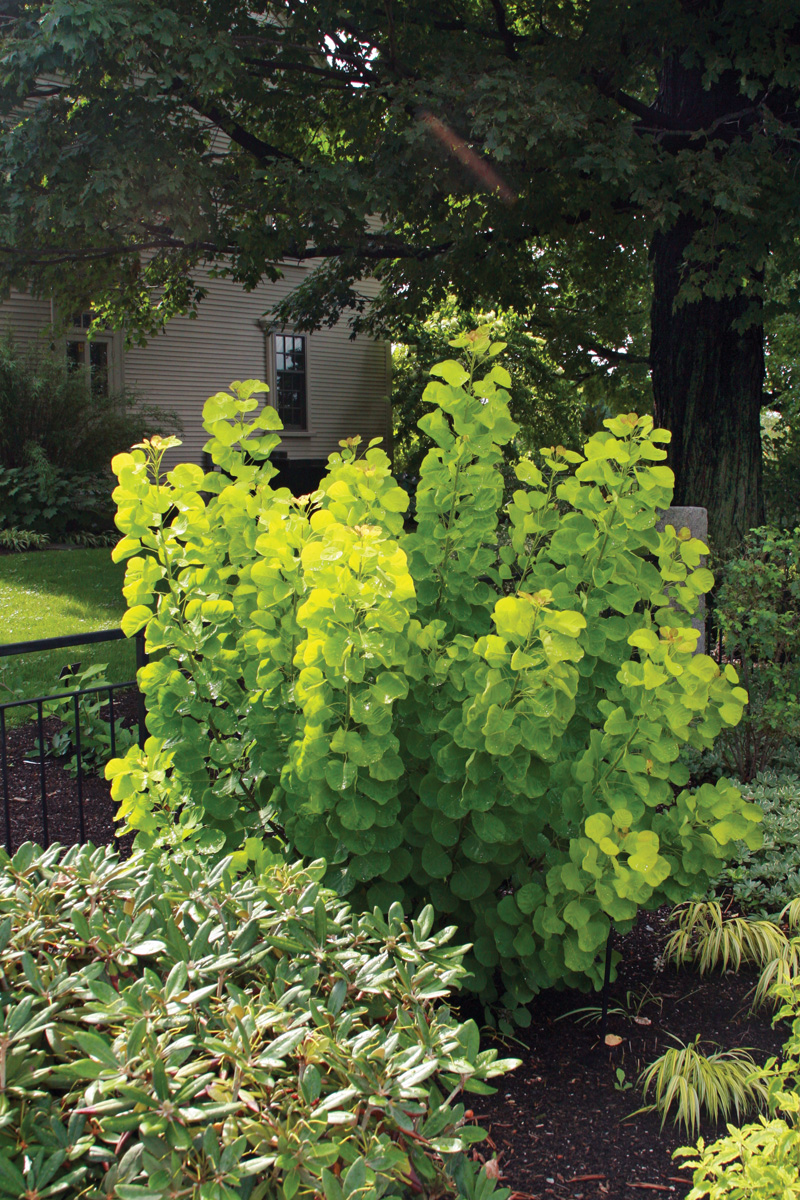
Name: Cotinus coggygria ‘Ancot’
Zones: 5–8
Size: 8 to 15 feet tall and wide
Conditions: Full sun to partial shade; average to dry, rocky soil
Native range: Asia and Europe
Gardeners in deer country deserve a medal for resiliency, and this standout smokebush is a fitting prize for hanging in there. Its spectacular foliage changes color three times in a season, emerging lime green in spring, shifting to brilliant gold in summer, and finishing with tints of technicolor coral, orange, and red in fall. Some plants, especially older ones, develop airy, smoky puffs of flowers in summer. Golden Spirit™ loves full sun and will adapt to partial shade, where it does not grow quite as tall. In a recent design, I planted it with Russian sage (Salvia yangii, Zones 5–9) and ‘Blue Shadow’ fothergilla (Fothergilla × intermedia ‘Blue Shadow’, Zones 5–8) to create a completely deer-resistant perennial vignette.
Variegated sweet iris
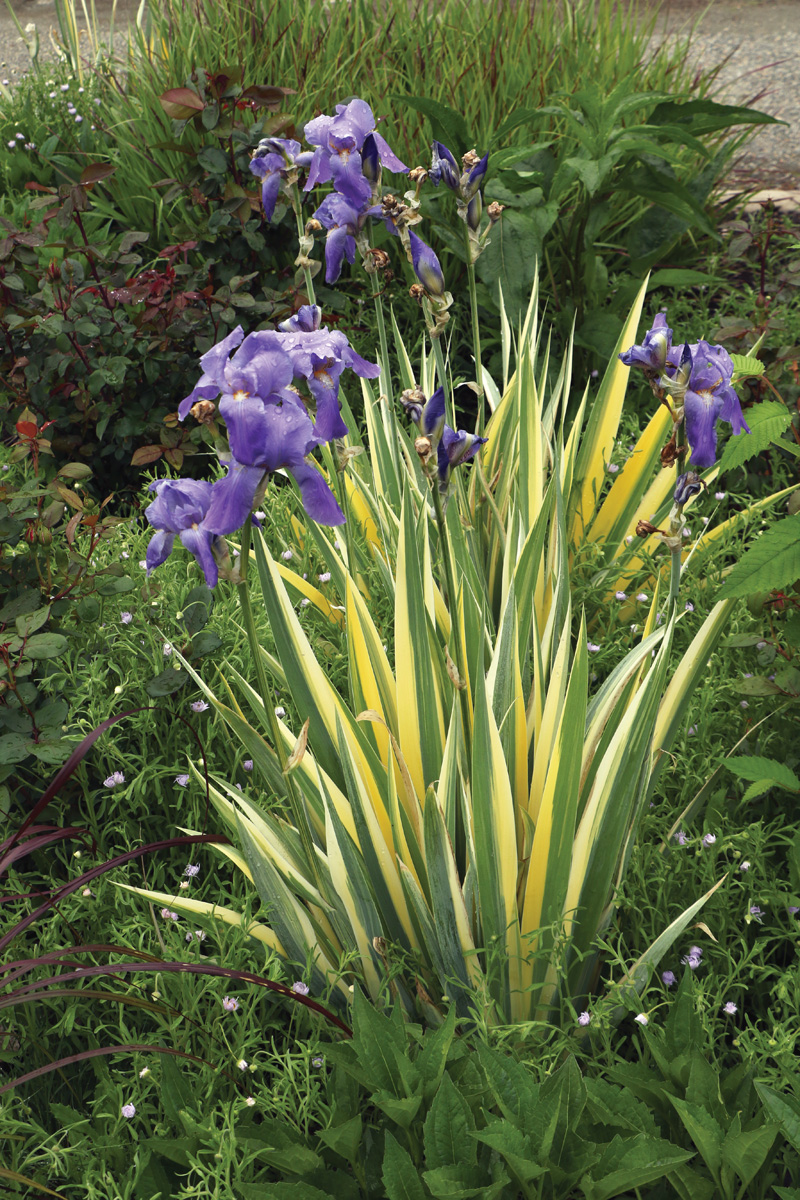
Name: Iris pallida ‘Variegata’
Zones: 4–9
Size: 24 to 36 inches tall and 18 to 24 inches wide
Conditions: Full sun to partial shade; average to moist, well-drained soil
Native range: Croatia
Neither deer nor rabbits like iris, which makes them must-have plants at my house. What I love about this cultivar is the variegated foliage; it is a cool mix of gray-green streaked with creamy yellow. While other irises have a brief period of interest that finishes when the blooms fade, the foliage of variegated sweet iris stays up and offers excellent color and vertical shape. Irises are easy to grow if you plant them correctly; instead of burying the rhizomes deeply, place them close to the soil’s surface to prevent rot. Try ‘Variegata’ next to a companion with red or burgundy foliage for a high-contrast color combination that looks fabulous for most of the growing season.
‘Aureola’ Japanese forest grass
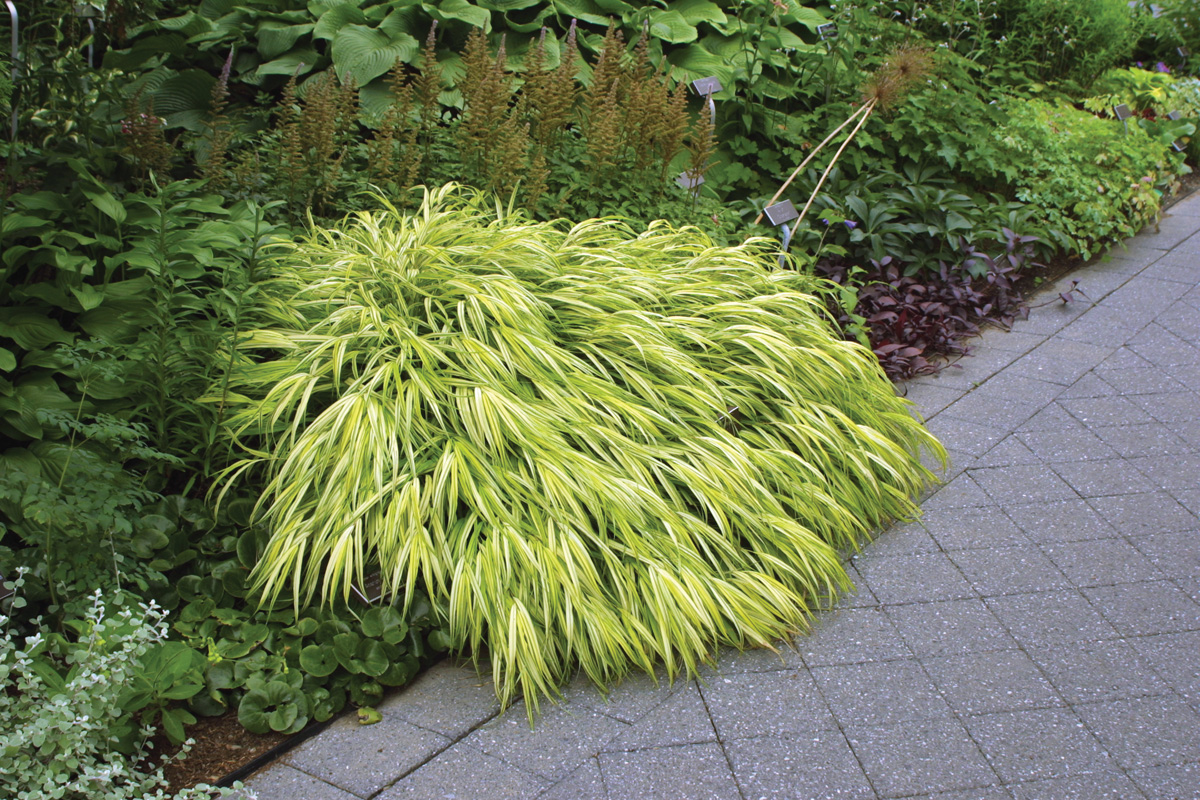
Name: Hakonechloa macra ‘Aureola’
Zones: 5–9
Size: 1 to 2 feet tall and wide
Conditions: Partial shade; average to moist soil
Native range: Central Japan
Is there anything this plant can’t do? It grows in full shade and even in full sun, though in full sun it gets a little burned by the end of summer. It adds color, texture, and movement, and is deer resistant to boot. Its yellow cascading leaves with green variegation have a soothing look that is more subtle than the blazing chartreuse foliage of its sibling, ‘All Gold’. I interchange these two cultivars, depending on the look I am going for. ‘Aureola’ looks wonderful surrounding a tree, preferably one with dark foliage for contrast. It is also fantastic to use in front of shrubs or at the edge of a border filled with vertical plants. I am so grateful that the deer don’t eat this endlessly useful, adaptable plant. Rabbits, however, have started taking nibbles.
‘Six Hills Giant’ catmint
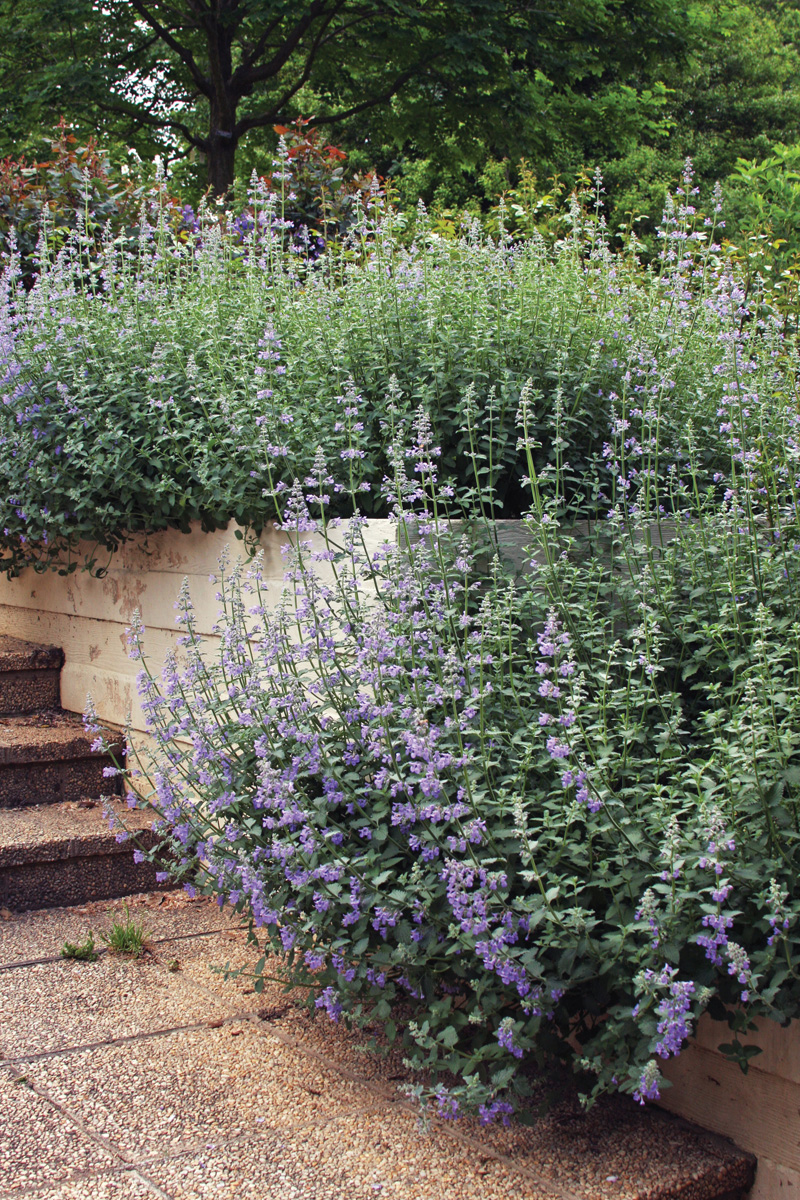
Name: Nepeta ‘Six Hills Giant’
Zones: 4–7
Size: 2 to 3 feet tall and 2 to 4 feet wide
Conditions: Full sun to partial shade; dry to average, well-drained soil
Native range: Asia and Europe
Deer-resistant plants are just like cheese—the stinkier they are, the better. Catmint has a minty smell that deer don’t like, so they ignore it. But fragrance isn’t the only quality that makes ‘Six Hills Giant’ a winner. This superstar plant is easy to grow and practically impossible to kill, and it flowers profusely all season long. The key to keeping it tidy is to shear it after the first flowering to get a repeat bloom. It tends to look ragged if it isn’t sheared, and that’s when people’s love for it sours. I particularly like ‘Six Hills Giant’ because it does not mushroom in size and take over a bed the way some other cultivars do. Pair it with peonies (Paeonia spp. and cvs., Zones 3–8), which are also deer resistant, for a romantic look.

Regional expert: Caitlyn Boyle is a landscape designer, writer, and speaker who owns Dirt Diva Designs in Chatham, New Jersey. She is also a regional reporter for FineGardening.com
Northeast
‘Byakko’ fragrant Solomon’s seal
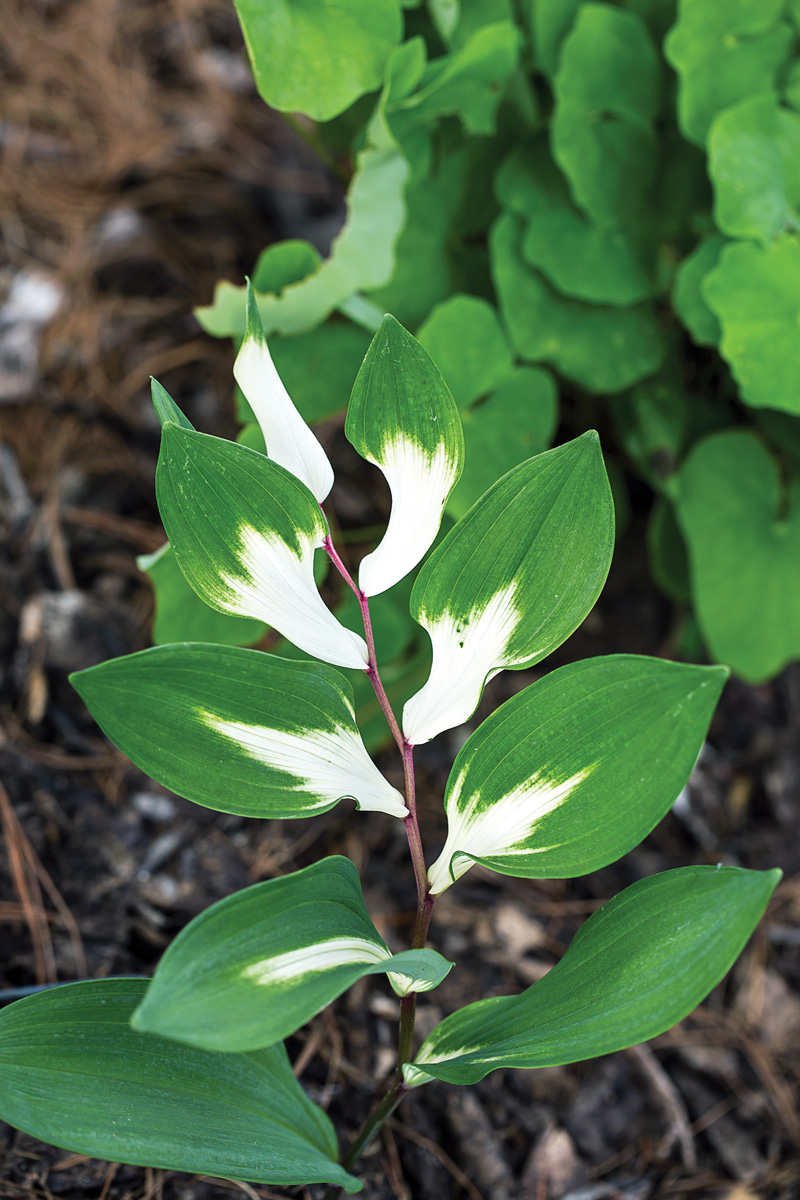
Name: Polygonatum odoratum ‘Byakko’
Zones: 4–9
Size: 12 to 20 inches tall and 18 to 24 inches wide
Conditions: Partial to full shade; rich, moist, well-drained soil
Native range: Asia and Europe
With its graceful, arching habit and small bell-like flowers, ‘Byakko’ has a deceptively delicate appearance. In actuality, this is a nearly indestructible woodland plant that is reliably herbivore resistant and will even withstand trampling hooves as deer make their way over to the hostas (Hosta spp. and cvs., Zones 3–8) you might have attempted to interplant with it. ‘Byakko’ is a particularly beautiful selection that begins life plain green but magically develops bright white streaks with maturity, like a duckling becoming a swan. Growing from thick, shallowly rooted rhizomes, this is an easy plant to propagate and transplant. Be sure to provide it with soil that is rich in organic matter.
‘Dark Towers’ penstemon
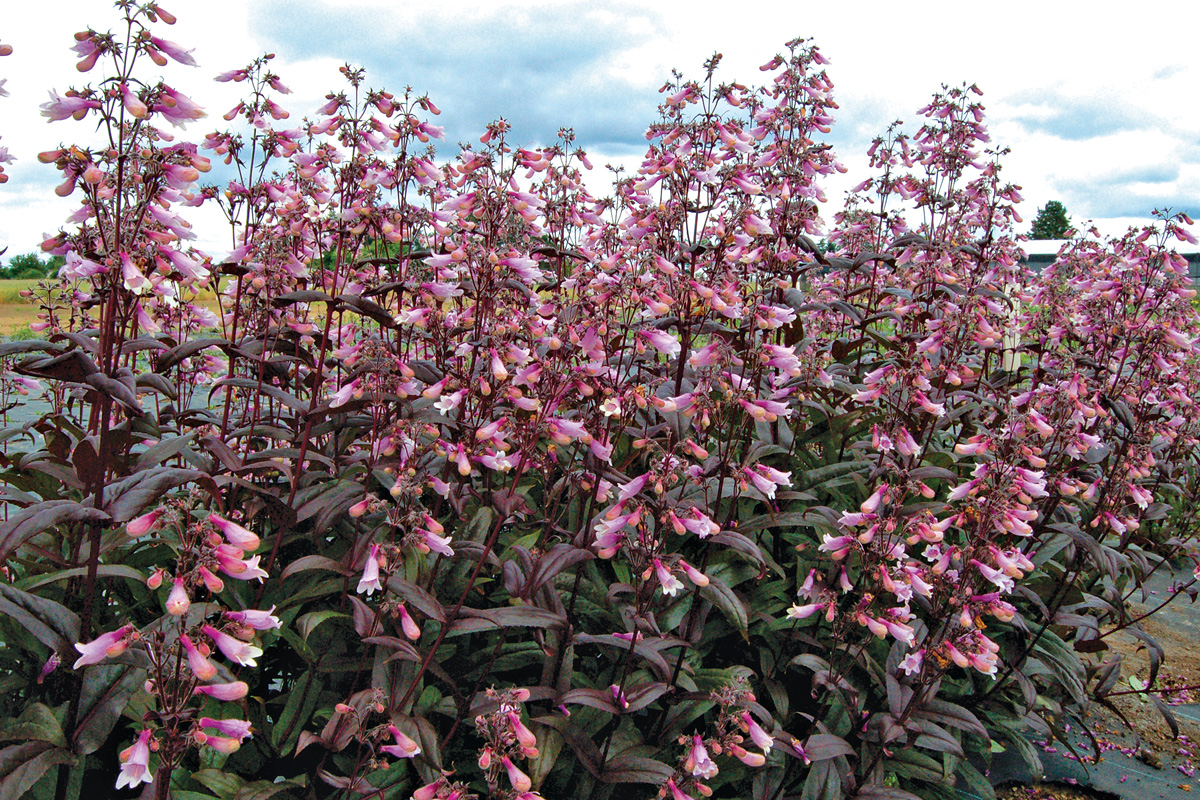
Name: Penstemon ‘Dark Towers’
Zones: 3–8
Size: 1½ to 3 feet tall and 1 to 2 feet wide
Conditions: Full sun; dry to medium, well-drained soil
Native range: Hybrid of North American species
To my knowledge, I’ve never had a penstemon even drooled on by deer, and with such a variety of species and selections in the genus, there’s one to fit any garden. The penstemon that currently has me starry-eyed is ‘Dark Towers’, a hybrid of ‘Prairie Splendor’ (P. ‘Prairie Splendor’, Zones 4–8) and the widely planted ‘Husker Red’ (P. digitalis ‘Husker Red’). While it looks similar to ‘Husker Red’, its stouter habit and persistent burgundy leaf color make it a much-improved offspring. This upright and tidy plant can be an excellent accent in naturalistic and formal gardens alike. Deadheading will keep the foliage looking sharp all season, though the seed heads can be gloriously ornamental if left standing.
Fringed bleeding heart
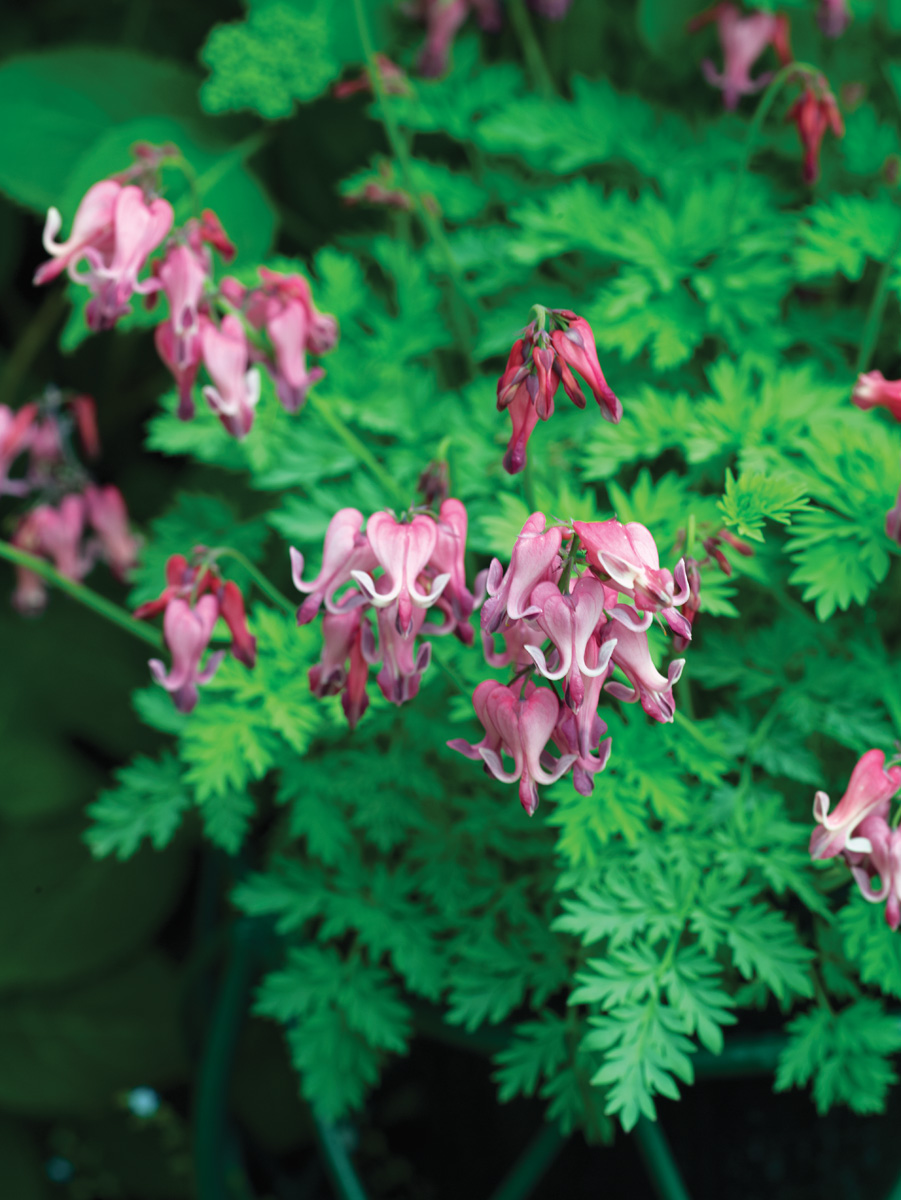
Name: Dicentra eximia
Zones: 3–9
Size: 1 to 1½ feet tall and wide
Conditions: Partial shade; moist, well-drained soil
Native range: Eastern United States
Our eastern native bleeding heart might be the perfect perennial. Unlike the ephemeral common bleeding heart (Lamprocapnos spectabilis, Zones 3–9), it produces dainty medium-pink flowers from mid-spring all the way through fall. Even if it pauses flowering in periods of high heat, the glaucous, ferny foliage continues to provide interest. While it definitely looks its best with some moisture
and shade, I’ve found it to be very tolerant of heat and drought. If the foliage does become stressed by poorer conditions, I cut it back and it flushes out again. Keep in mind that those copious flowers mean copious seeds will follow, and because nothing seems to eat this unfussy beauty, you can certainly expect many new plants to emerge year after year.
‘Gotemba’ aralia
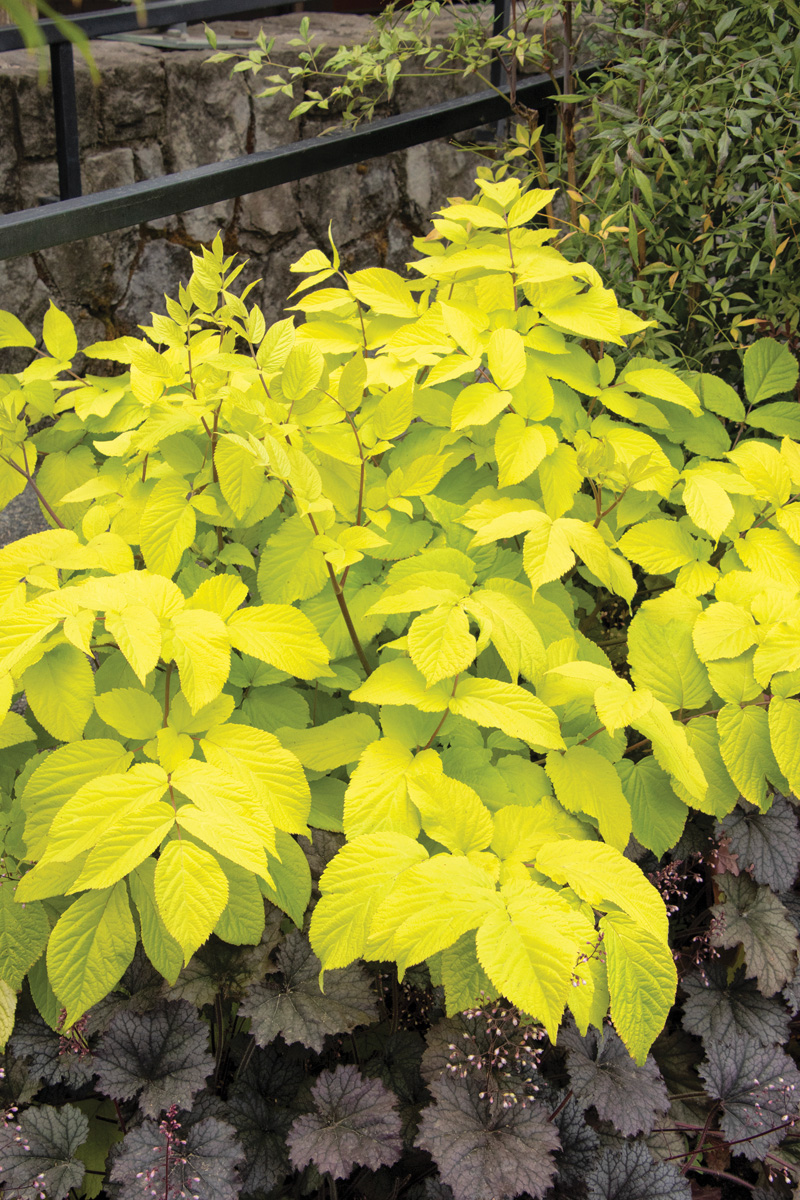
Name: Aralia cordata ‘Gotemba’
Zones: 4–10
Size: 4 to 6 feet tall and wide
Conditions: Partial shade; moist, well-drained soil
Native range: Eastern Asia
Growing rapidly to over 4 feet tall, ‘Gotemba’ aralia is an “I can’t afford a shrub at the moment but really need one” plant. This perennial is a deer-proof solution when you want a large and arresting focal point. It is easygoing enough to lend its golden brilliance to different environments. While it can handle some sun with consistent moisture, its greatest value is in electrifying difficult shady spots where dramatic options can be limited. You might also include this aralia in a perennial vegetable planting, as its spring shoots are perfectly edible, tasting similar to asparagus. ‘Sun King’ (A. ‘Sun King’, Zones 4–8) is the most commonly sold variety of aralia and looks very similar to ‘Gotemba’, but to my eye the latter maintains a superior golden-yellow hue, even in deeper shade.
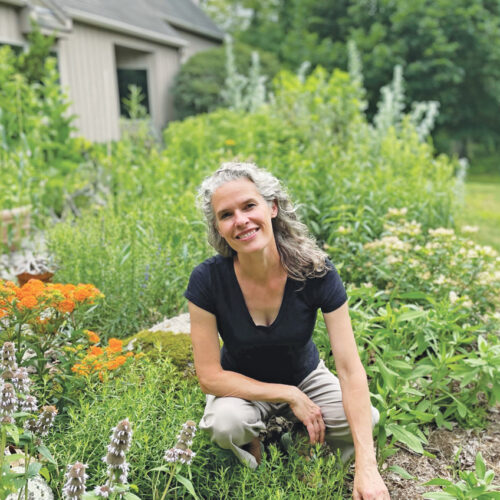
Regional expert: Chloë Bowers has worked as a gardener and landscape designer for 20 years. She lives and gardens in Newtown, Connecticut, and is also a Northeast regional reporter and forum moderator at FineGardening.com.
Regional expert photos: courtesy of the contributors.
Fine Gardening Recommended Products
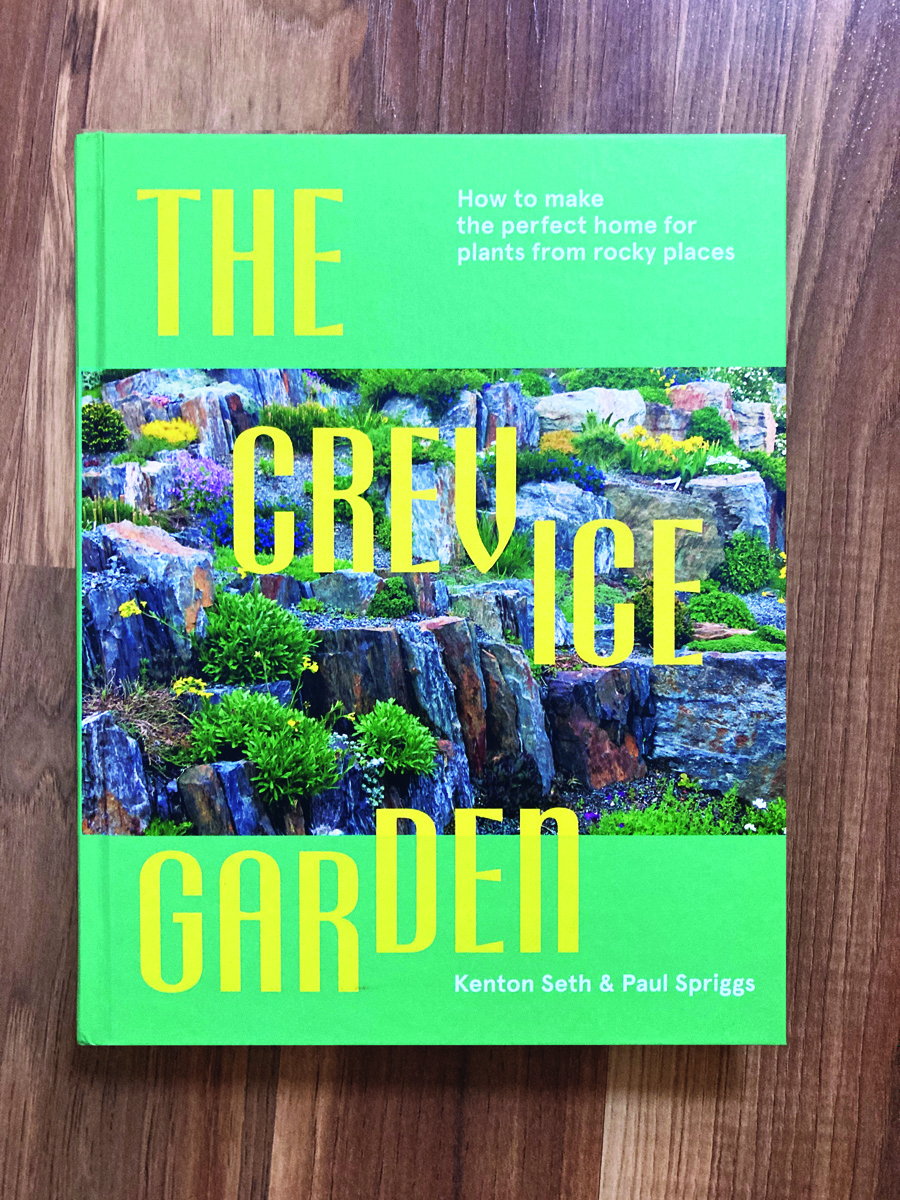
The Crevice Garden: How to make the perfect home for plants from rocky places
Fine Gardening receives a commission for items purchased through links on this site, including Amazon Associates and other affiliate advertising programs.
A crevice garden replicates the environmental conditions of mountain tops, deserts, coastlines, and other exposed or rocky places on earth. These striking garden features provide perfect conditions for the plants native to these far-off places, bringing the cultivation of these precious gems within everybody’s reach.
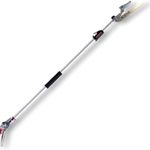
ARS Telescoping Long Reach Pruner
Fine Gardening receives a commission for items purchased through links on this site, including Amazon Associates and other affiliate advertising programs.
Telescopes from 4 to 7′. Cut and Hold (160) Blades. Drop forged blades for unsurpassed long lasting sharpness. Lightweight, 2.3 lbs., for continued use. Perfectly balanced for easy pruning.
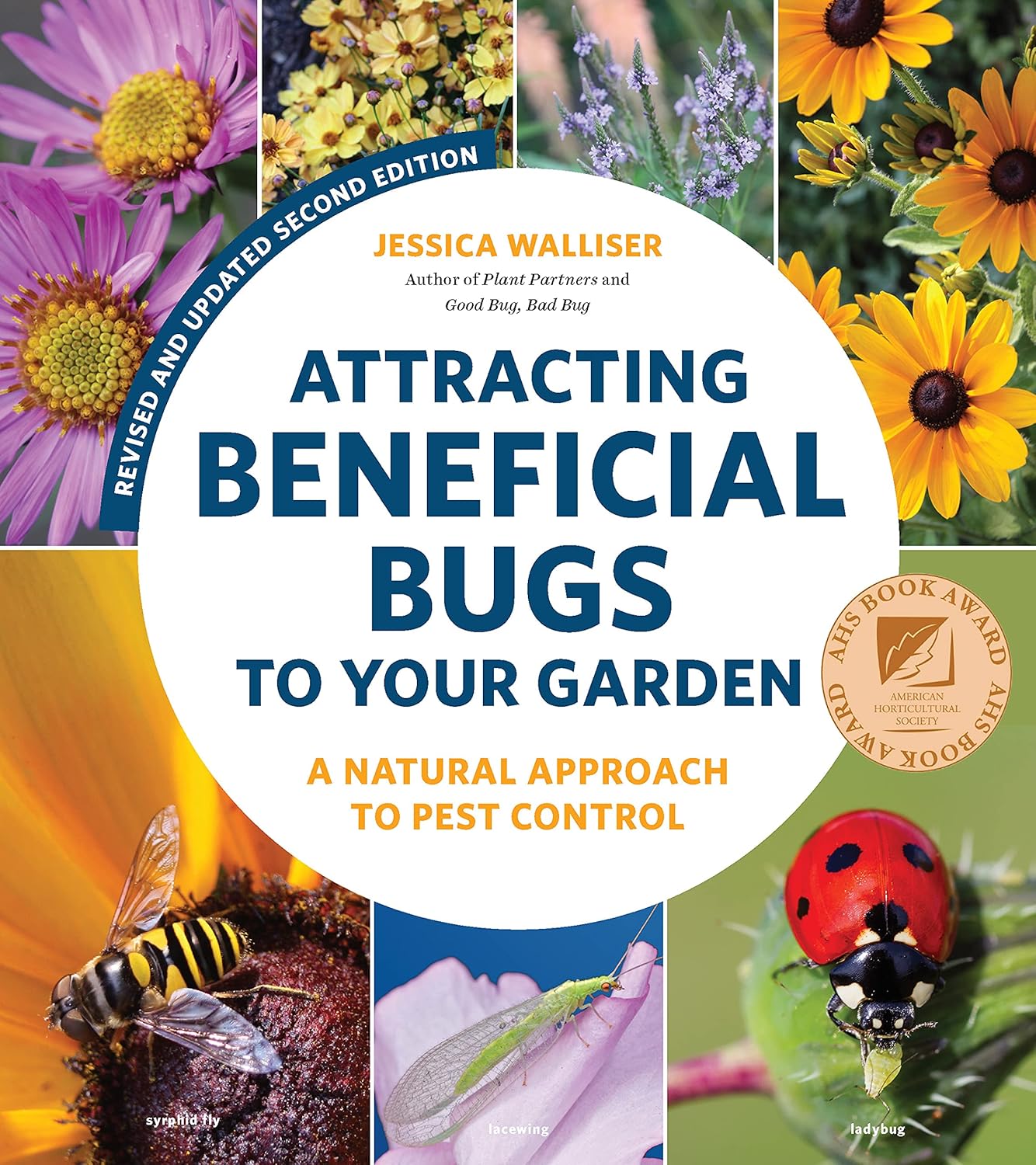
Attracting Beneficial Bugs to Your Garden, Revised and Updated Second Edition: A Natural Approach to Pest Control
Fine Gardening receives a commission for items purchased through links on this site, including Amazon Associates and other affiliate advertising programs.
This revised and updated edition of Jessica Walliser’s award-winning Attracting Beneficial Bugs to Your Garden offers a valuable and science-backed plan for bringing balance back to the garden. With this indispensable gardening reference—now updated with new research, insights, and voices—learn how to create a healthy, balanced, and diverse garden capable of supporting a hard-working crew of beneficial pest-eating insects and eliminate the need for synthetic chemical pesticides.




